This is the website of Abulsme Noibatno Itramne (also known as Sam Minter).
Posts here are rare these days. For current stuff, follow me on Mastodon
|
States with new poll data added since the last update: All 50 states, DC, and the Maine congressional districts
Notable changes in: Iowa, Georgia, Utah, Alaska, Indiana, Missouri, Maine (CD2), and the tipping point
National Summary
It has been about six days since my last update and the trend since then has been toward Trump. Here are the stats:
Good for Trump:
- The expected result changed from a 140 EV Clinton win to a 130 EV Clinton win
- The tipping point moved from Clinton by 4.9% in PA to Clinton by 4.1% in PA
- Clinton’s best case declined from a 238 EV win to only a 234 EV win
No change
- Trump’s best case remained a 34 EV win
Charts
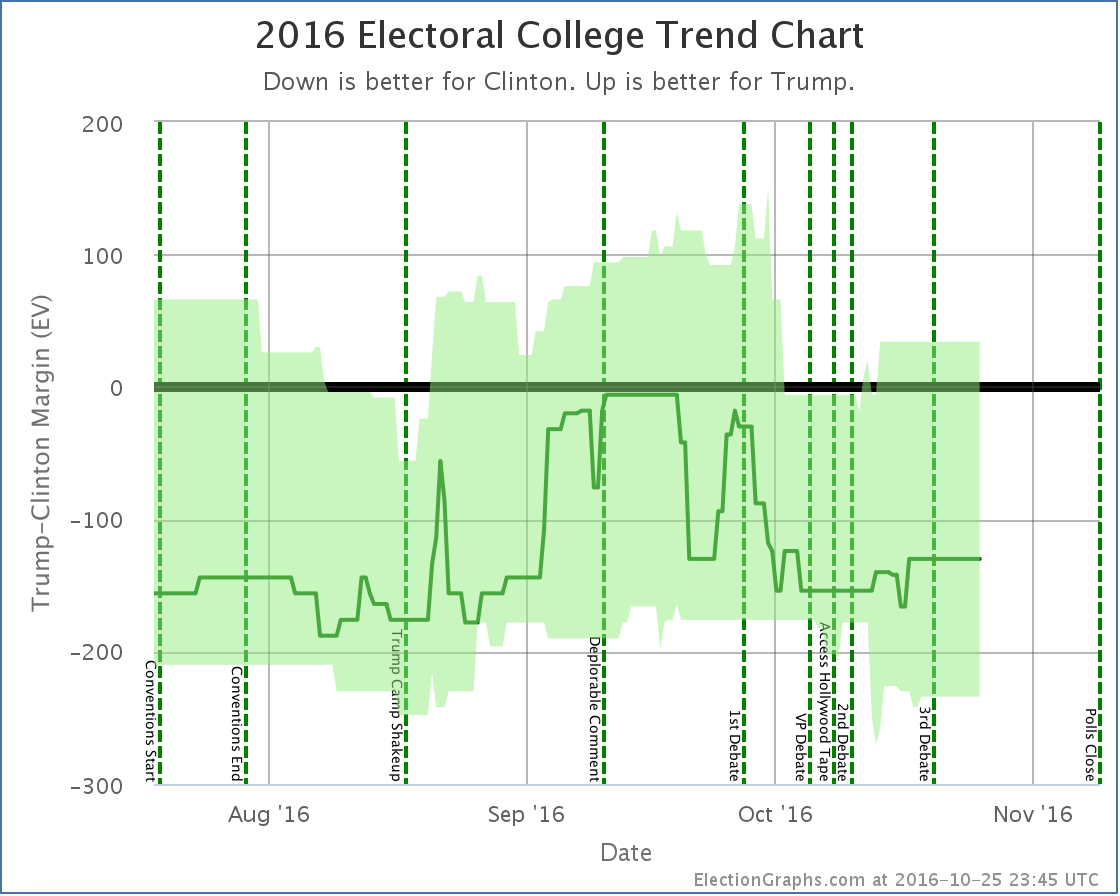
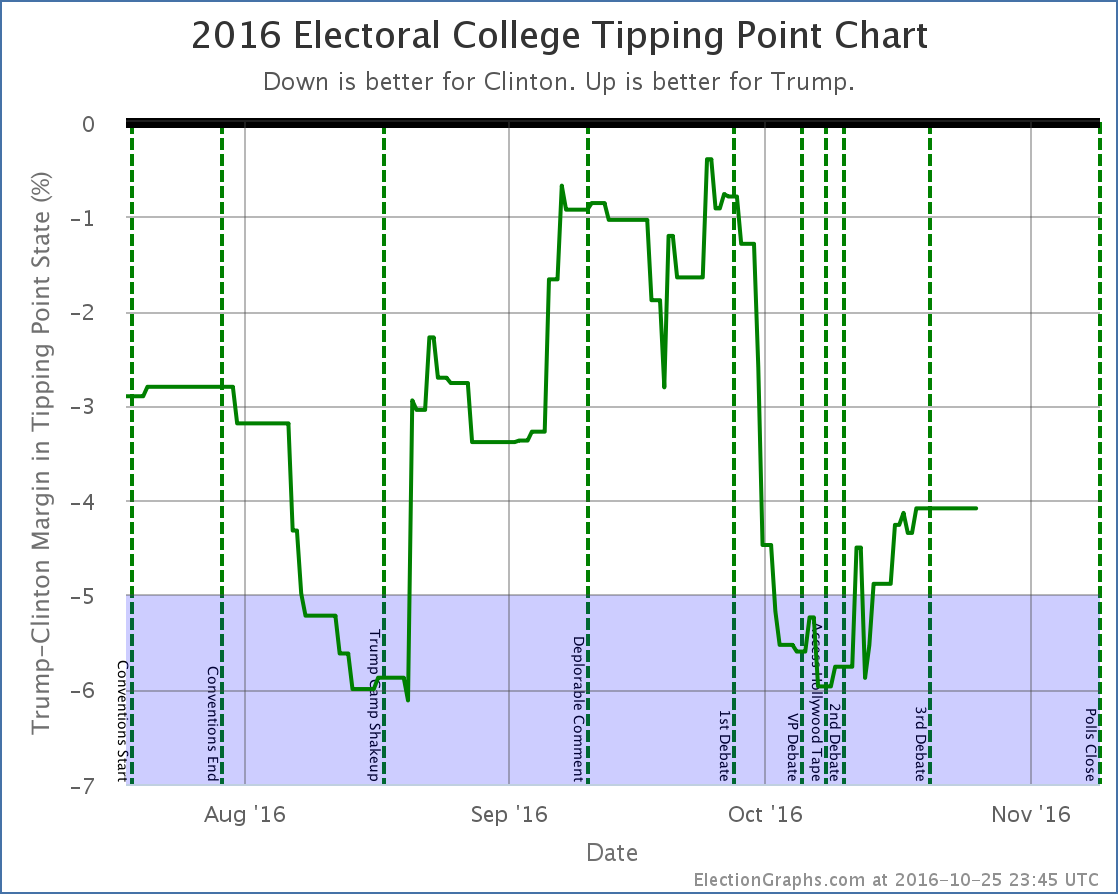
Discussion
With all the data we have now, looking back to the release of “the tape” on October 7th the overall movement has been mixed. Both candidates have improved their “best cases” as states that were not close have gotten closer… on both sides. So this doesn’t show a move toward one candidate or another, but rather some red states getting less red while simultaneously some blue states got less blue.
Some of the really close states moved across the center line… in both directions… resulting in a net movement of the expected electoral college margin toward Trump by 24 electoral votes… but the most indicative sign of movement toward Trump is actually the tipping point.
Since the release of the tape the tipping point has moved from Clinton leading by 6.0% (in Virginia) to Clinton leading by only 4.1% (in Pennsylvania). So… with some of the worst news cycles for a politician in decades, with day after day after day of negative revelations… Trump improved his position by nearly 2%.
How to interpret this? My best guess… Most people were pretty well set on their Trump vs Clinton choice prior to the reveal of the tapes and the subsequent sexual assault allegations. In the wake of the first debate the part of the public that was persuadable had already swung us from near Trump’s ceiling to near Trump’s floor. With the string of additional bad news, very few die hard Trump supporters moved away from him, while some number of those persuadables viewed this as the press piling on Trump and went back to him thinking this was unfair.
But to be honest, the above is trying to make up a story to fit the numbers. Is it right? I don’t know.
In the end though, the reality is that in the face of a hurricane of bad coverage, Trump has actually improved his position.
Despite the improvement, Trump is still losing by a significant margin, but Trump’s best case does still includes a win.
If he keeps all the states he leads, then flips Arizona, North Carolina, Florida and Pennsylvania, he could still pull out a narrow win. Arizona is close enough it could flip back easily enough. North Carolina and Florida have both been back and forth over the past couple months, so seeing them go red again would not be shocking.
Pennsylvania is the hard pull. While he made it close in September, Trump has never led in Pennsylvania. And Trump needs Pennsylvania to win. Right now, this is Clinton’s firewall.
Clinton would clearly like to be leading in Pennsylvania by more than 4.1%… but even at that margin, it is a tall wall for Trump to climb.
There are 13.7 days left until the first polls close. With less than two weeks left to go now, it is almost certainly too late for Trump to flip all the states he would need to flip in order to win. But if he manages to continue the trend of the last couple of weeks, it is enough time for him to make it close enough that Democrats will start to panic.
State Details
The following are the detailed state charts for states that influenced the status changes since the last update.
Weak Clinton to Weak Trump
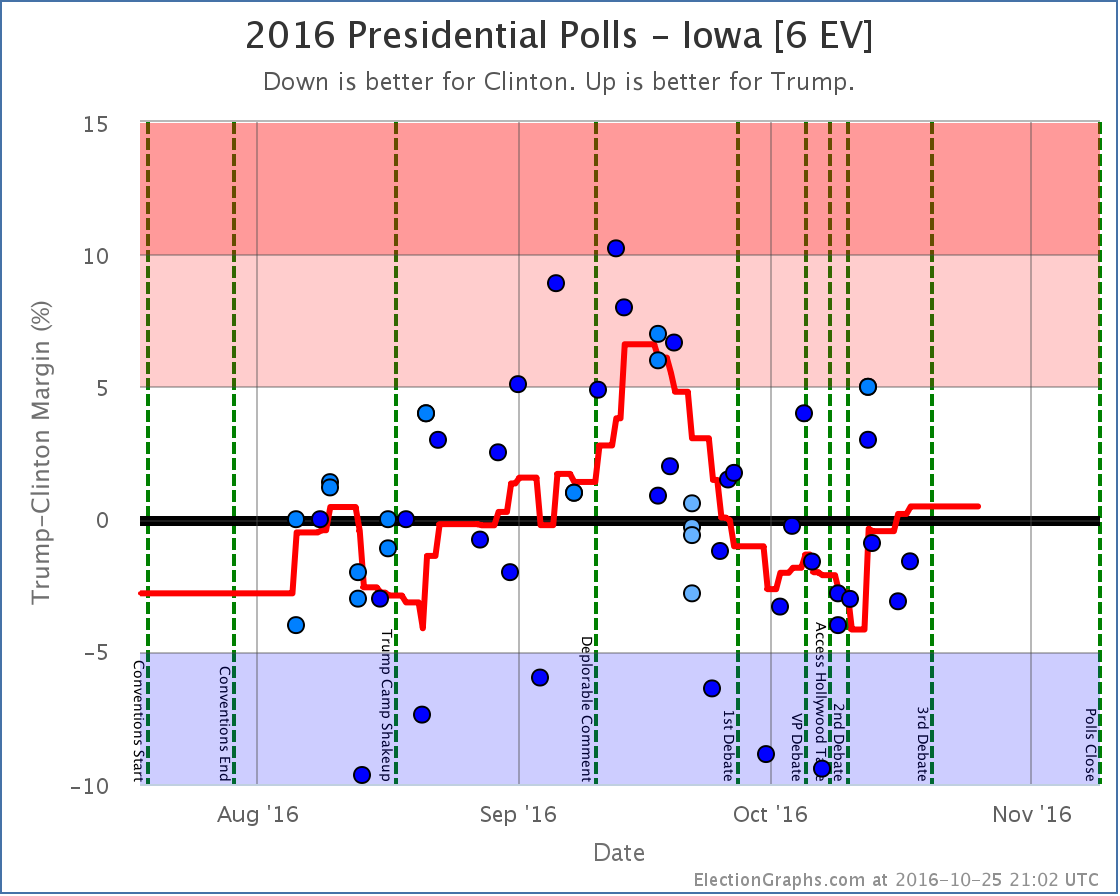
Weak Trump to Weak Clinton
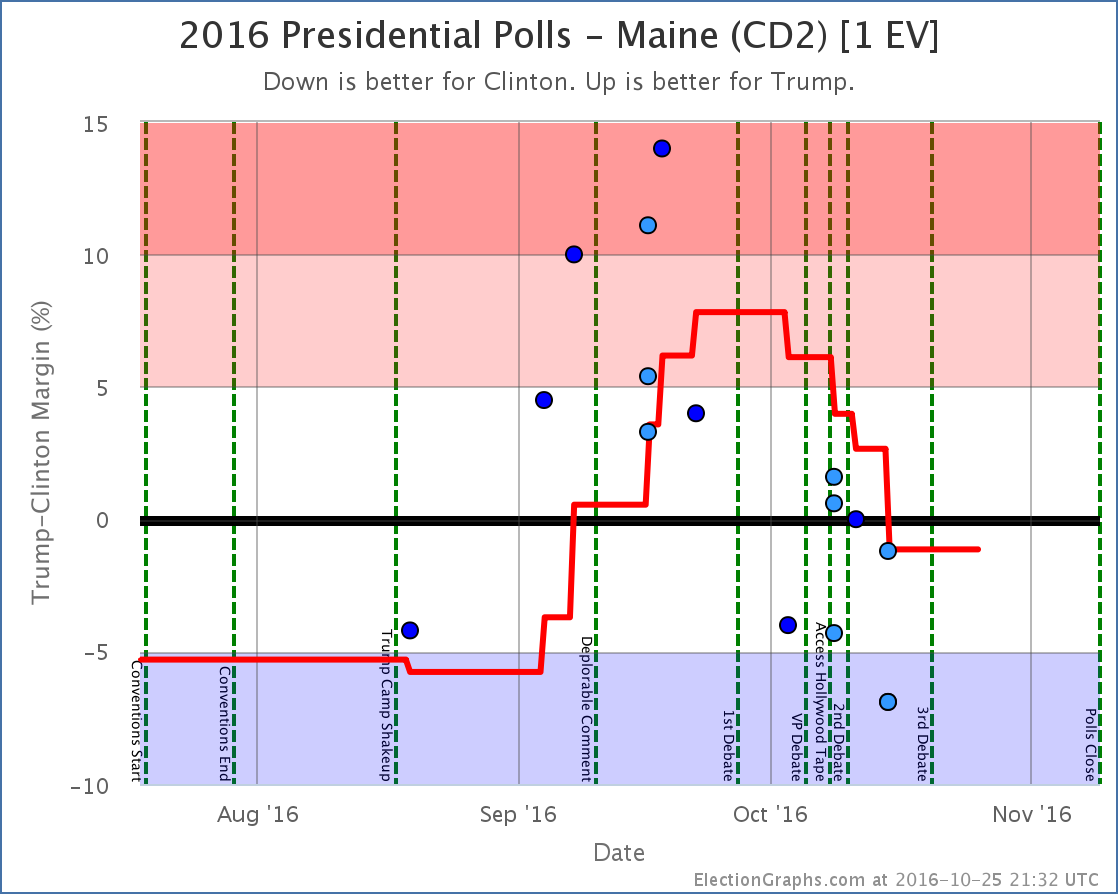
Influencing the tipping point
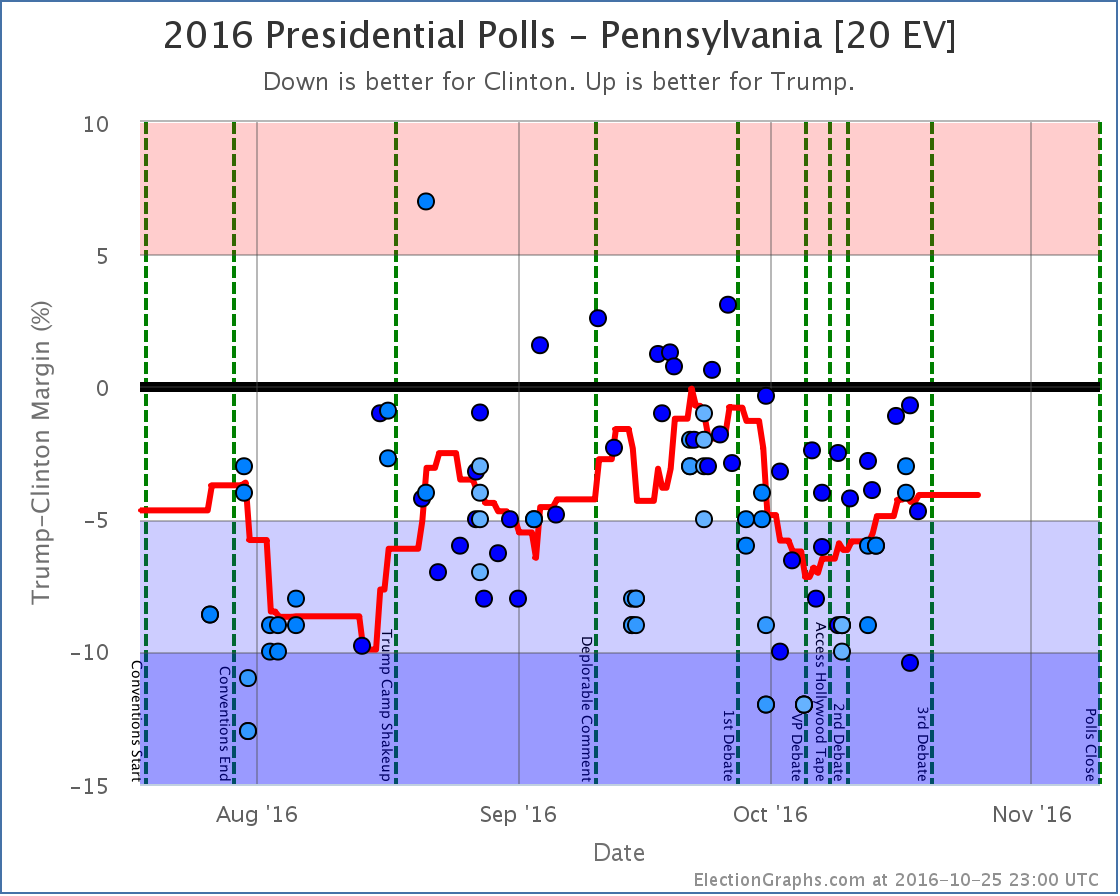
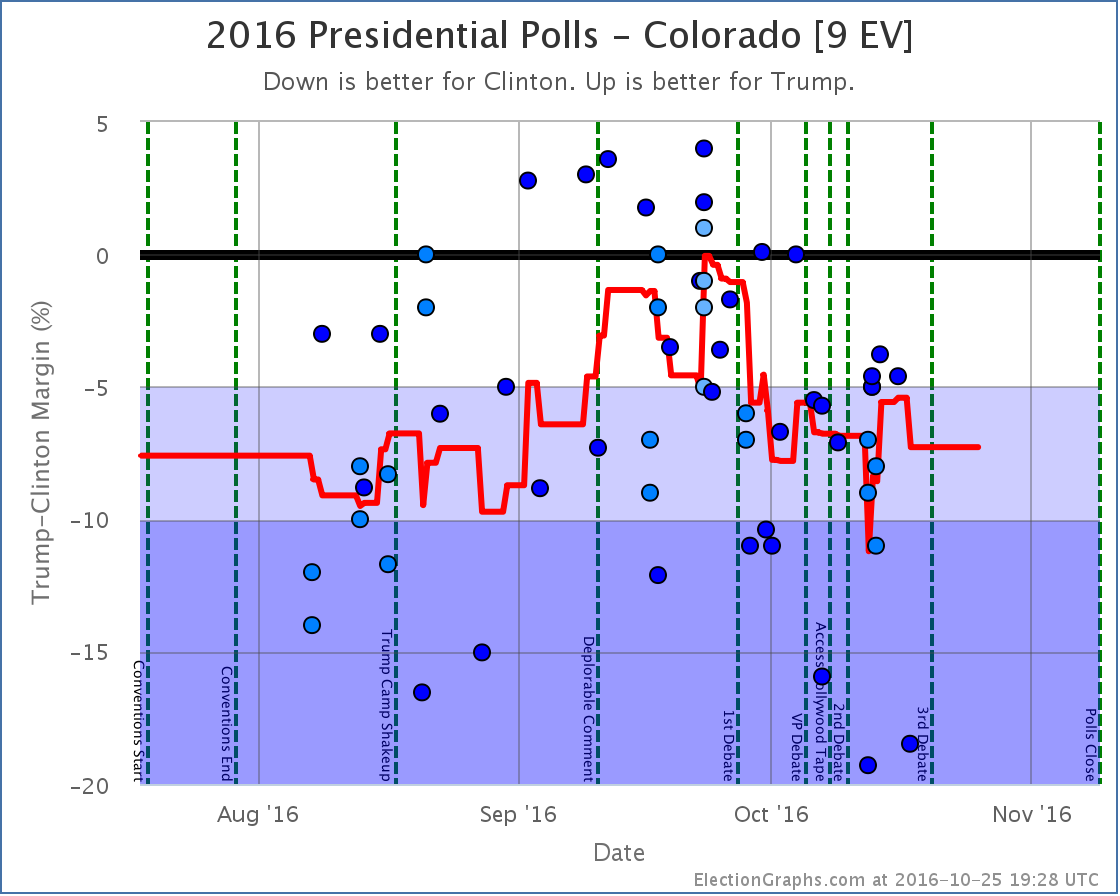
Now possible Clinton pickups
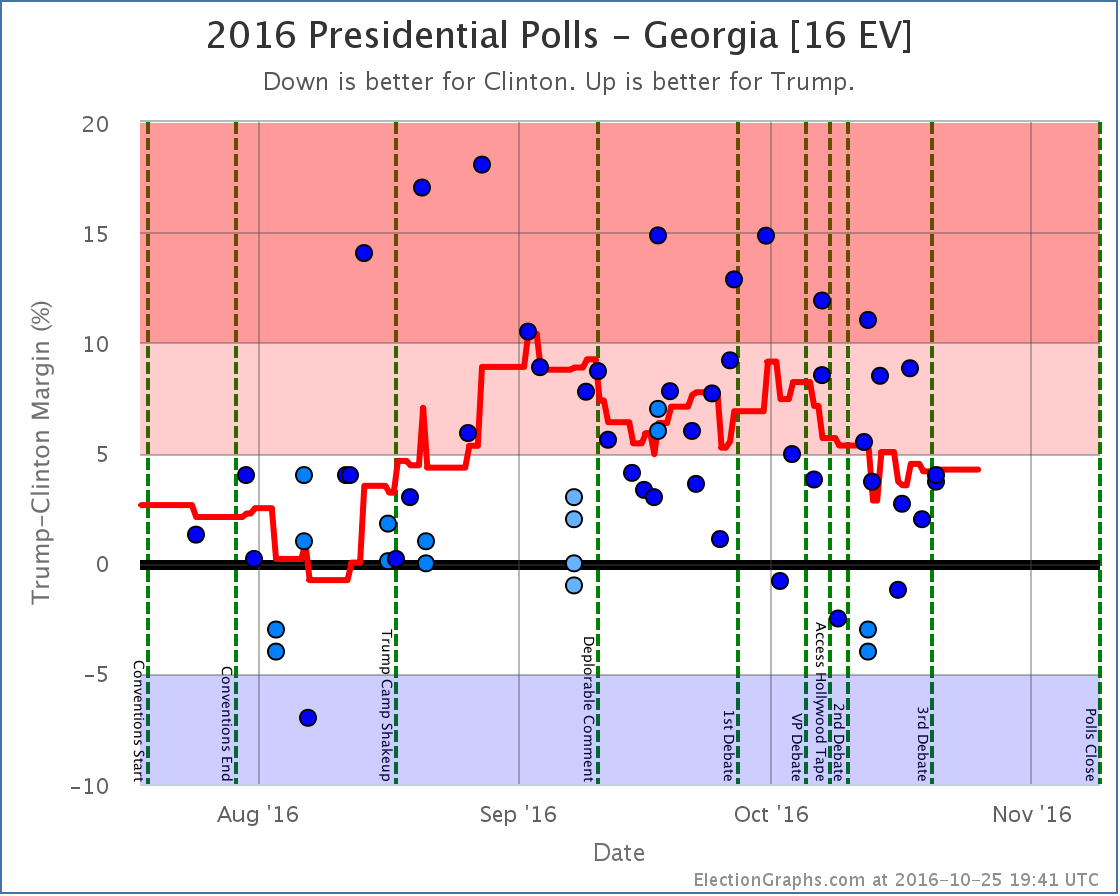
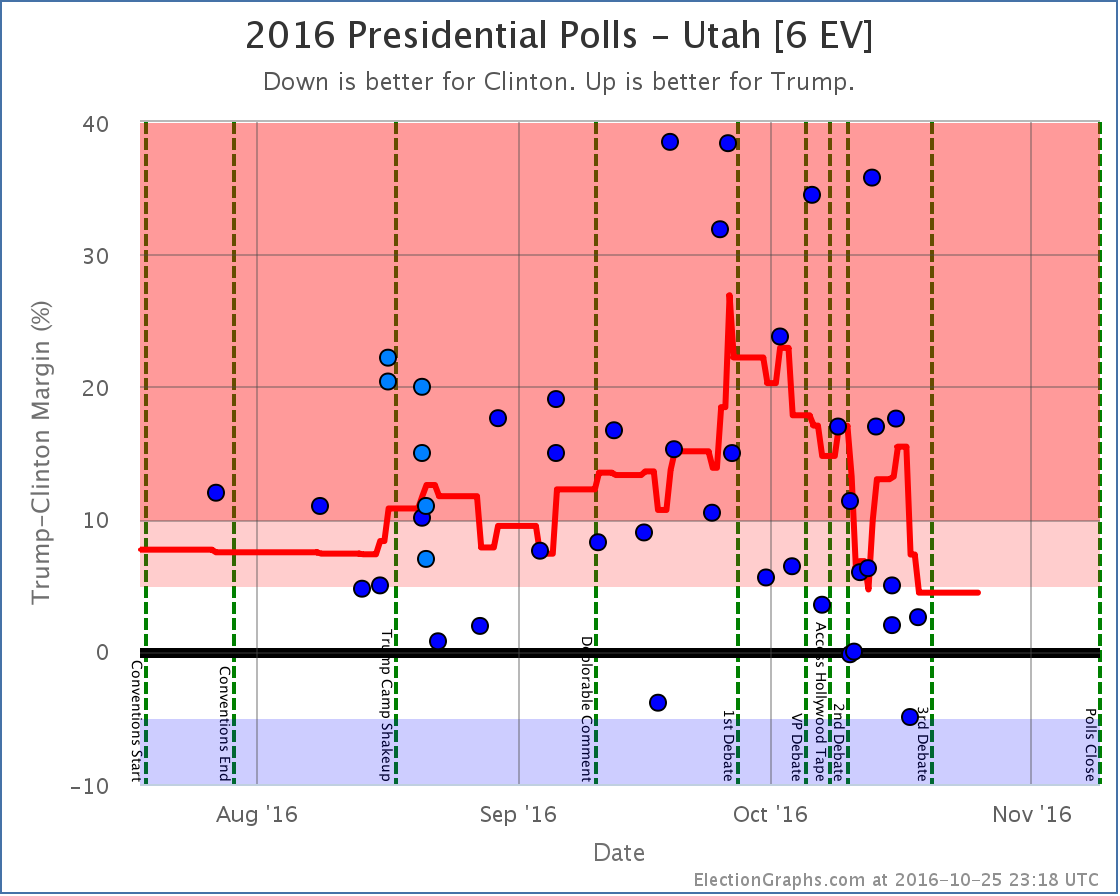
No longer possible pickups for Clinton
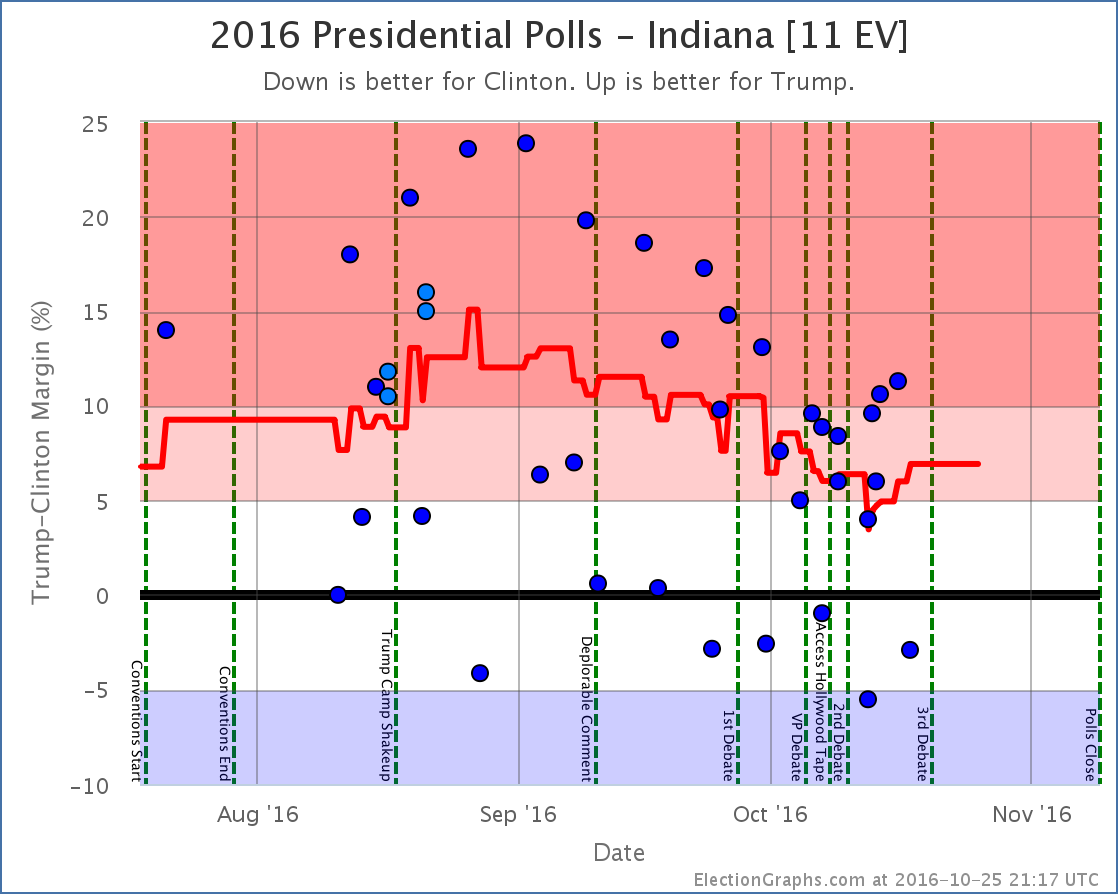
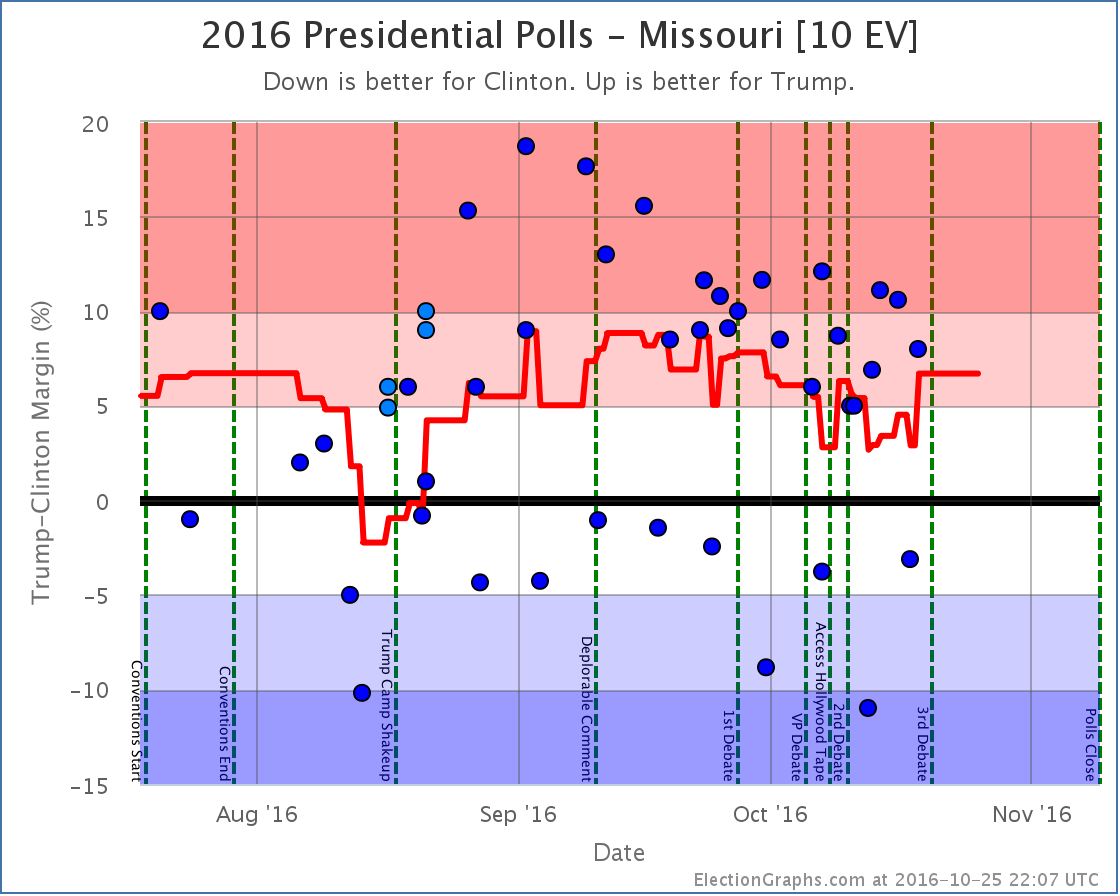
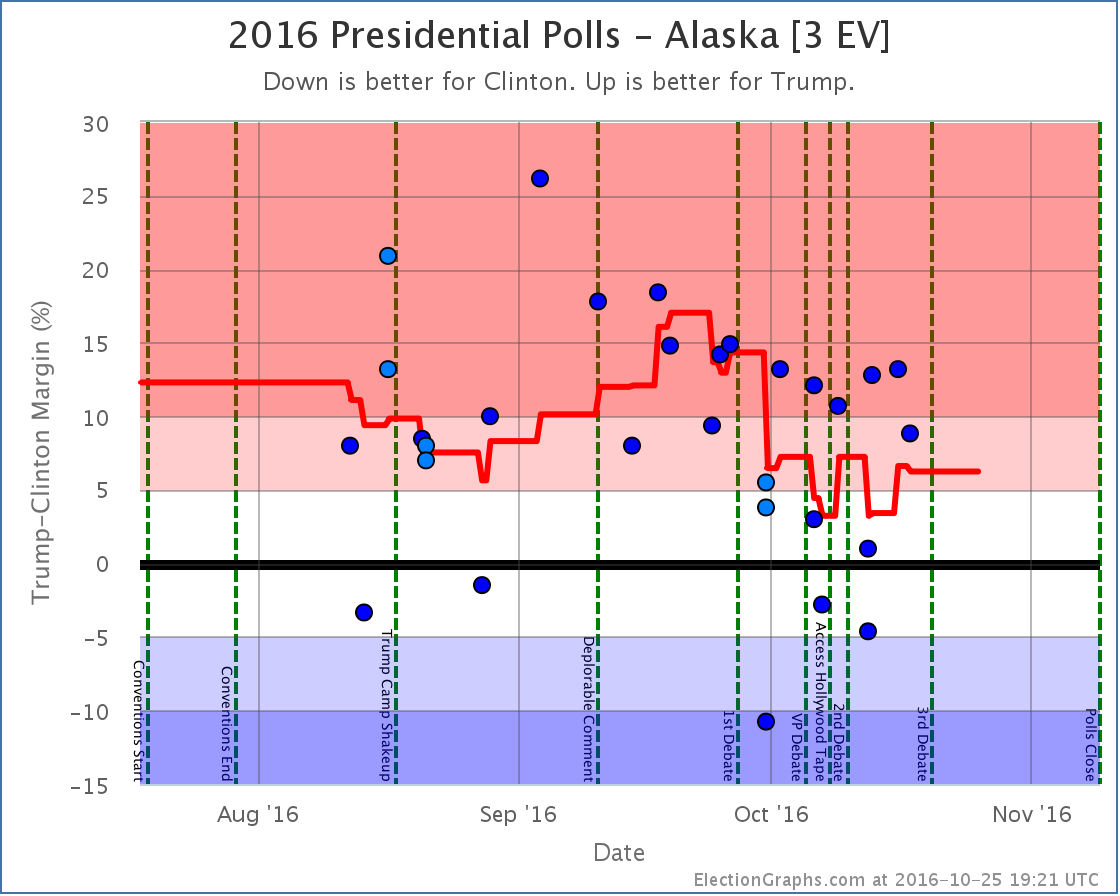
A note about McMullin
Election Graphs is designed around showing the Republican – Democrat margin, and there is not enough time before the election to revamp the site to properly account for 3rd parties that are strong enough to have a shot at winning electoral votes.
Right now the Real Clear Politics average in Utah has McMullin 5.5% behind the lead. The 538 average in Utah has him 8.5% behind the lead. If/when McMullin is within 5% according to either of these averages, I will add notes to both the Utah and National pages about the possibility of McMullin winning Utah’s 6 electoral votes.
For more information…
This post is an update based on the data on ElectionGraphs.com. Election Graphs tracks a state poll based estimate of the Electoral College. All of the charts and graphs seen in this post are from that site. Additional graphs, charts and raw data can be found there. Follow @ElectionGraphs on Twitter or like Election Graphs on Facebook to see announcements of updates or to join the conversation. For those interested in individual general election poll updates, follow @ElecCollPolls on Twitter for all the polls as they are added. If you find the information in these posts interesting or useful, please consider visiting the tip jar.
States with new poll data added since the last update: All of them. Multiple times. There are additional new polls since I had to cut things off for this update as well. Those will be in the next update.
National Summary
The last week of polls has been devastating to Trump’s position. In the last update we were just starting to see the reaction from the first debate. With this batch the post-debate polling continued to roll in, and while there were a couple of minor moves toward Trump, the net change in this update was a dramatic move toward Clinton:
- The expected result moved from Clinton by 6 electoral votes to Clinton by 154 electoral votes
- The tipping point moved from Clinton by 2.1% in CO to Clinton by 4.5% in MI
- Trump’s best case moved from a 60 EV win to a 26 EV win
- Clinton’s best case moved from a 208 EV win to a 196 EV win
Looking at the charts:
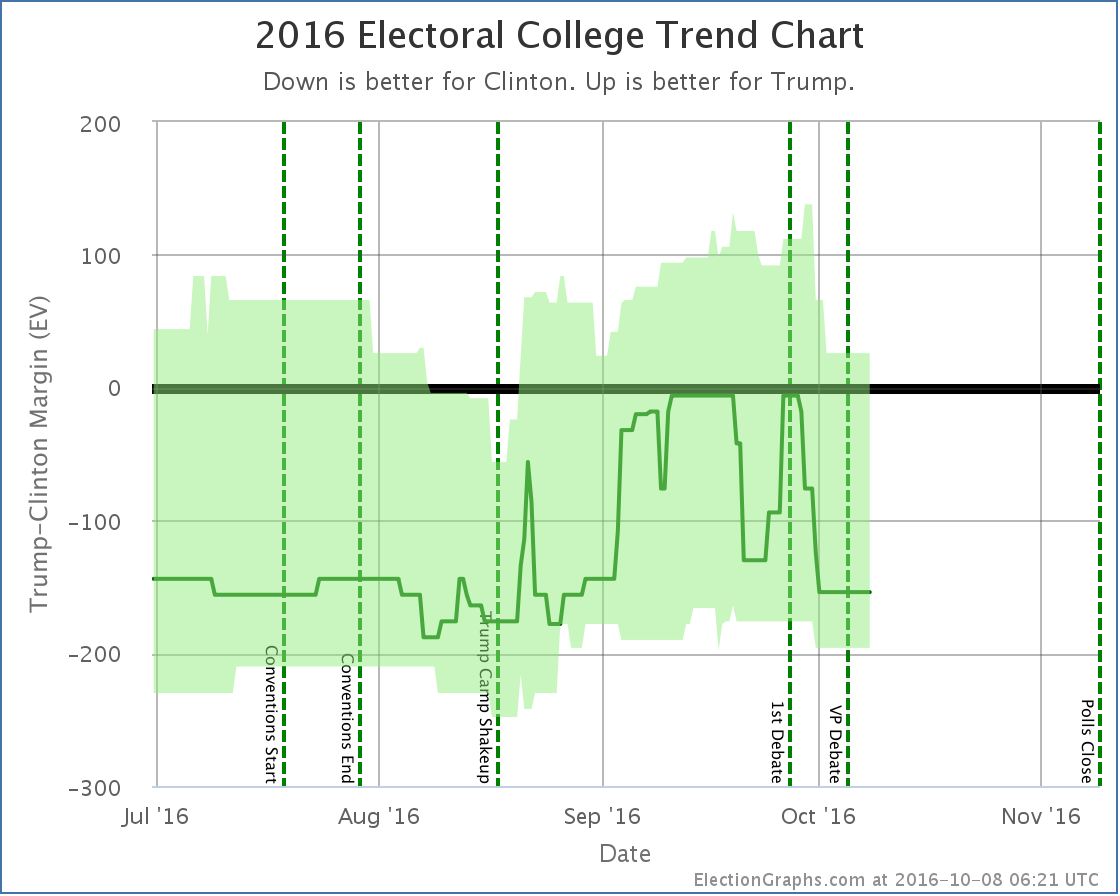
The previous update mentioned some Trump losses starting a week or two before the debate. With a lot more polls filling in the time period right before the debate as well as right after, it now looks like those losses were reversed before the debate.
In the time after the debate though, all three indicators on the chart have moved in Clinton’s direction. The race is now essentially back to where it was at the beginning of September. We’re not yet back at Clinton’s high point from August, but it is getting close.
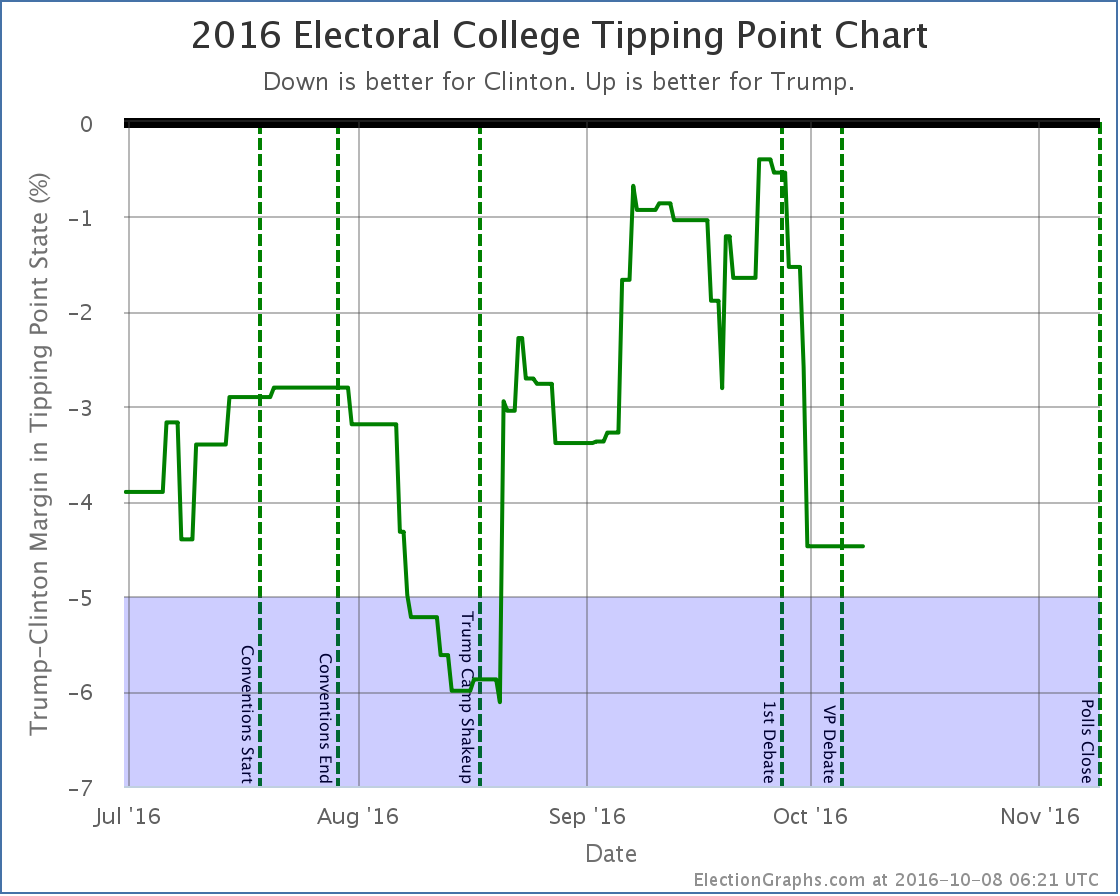
The tipping point chart is even more stark. As with the electoral college view, it looks like Trump’s mid-September declines were reversed by debate time, but after the debate everything falls off a cliff. Most of Trump’s gains from August and September are gone. Right before the debate he topped out with Clinton only ahead in the tipping point metric by 0.4%.
Clinton now leads by 4.5%. The tipping point state is Michigan. Clinton only has to increase her lead slightly there to not just take Michigan out of reach for Trump, but the Presidency.
What we are seeing in the polling results right now at this point probably fully factors in the debate itself. But we are just starting to see the impact from Trump’s “worst week in presidential campaign history ” that started with the debate, continued with his attacks on Alicia Machado, and ended with the leak of some of his tax information. The events of that week are not yet fully baked in.
And of course, the polls do not yet reflect the VP debate, or more importantly, the 2005 Trump video that was leaked on Friday. It is hard to imagine the events of the last few days NOT having an impact on the polls.
And the next debate is coming up. It should be interesting. If you were not planning on tuning in before, change your plans.
31.7 days left until the first actual election results start coming in.
State Details
A lot of states moved in order to produce the summary results above. For those interested in looking at the state by state details, they are below:
Weak Trump to Weak Clinton
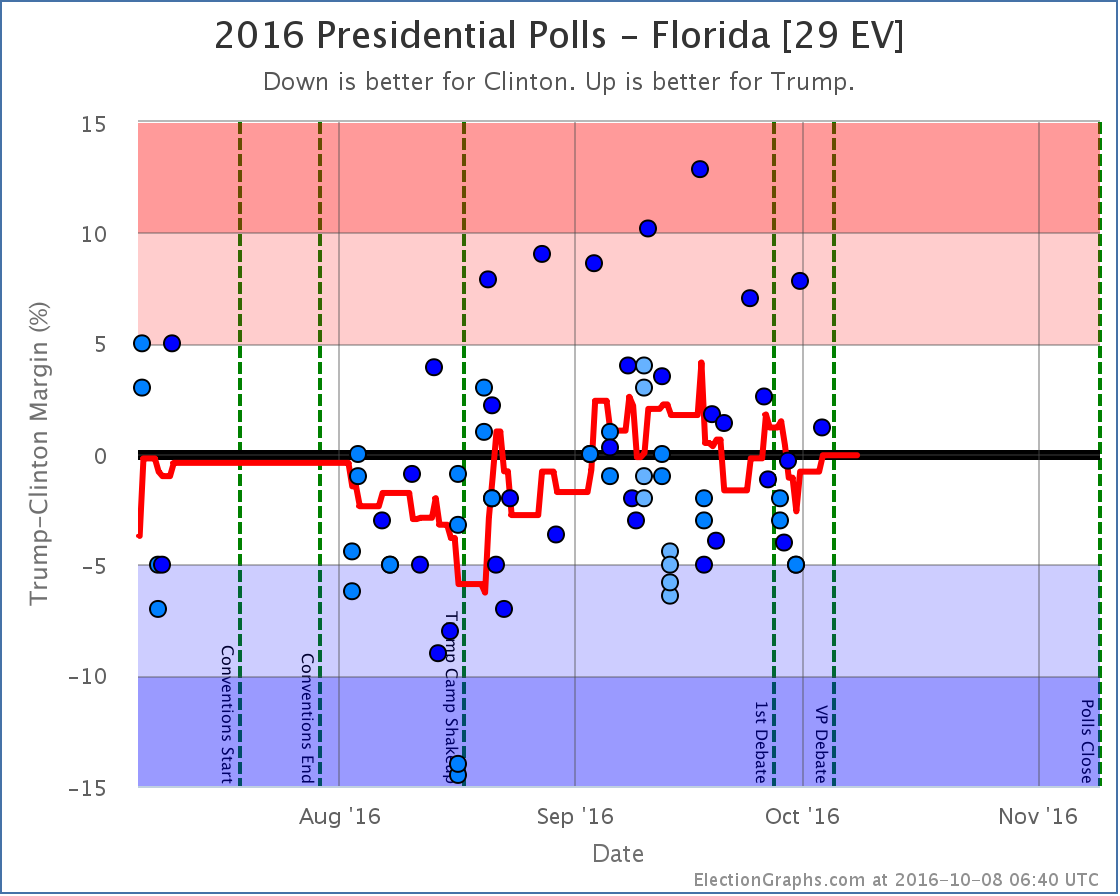
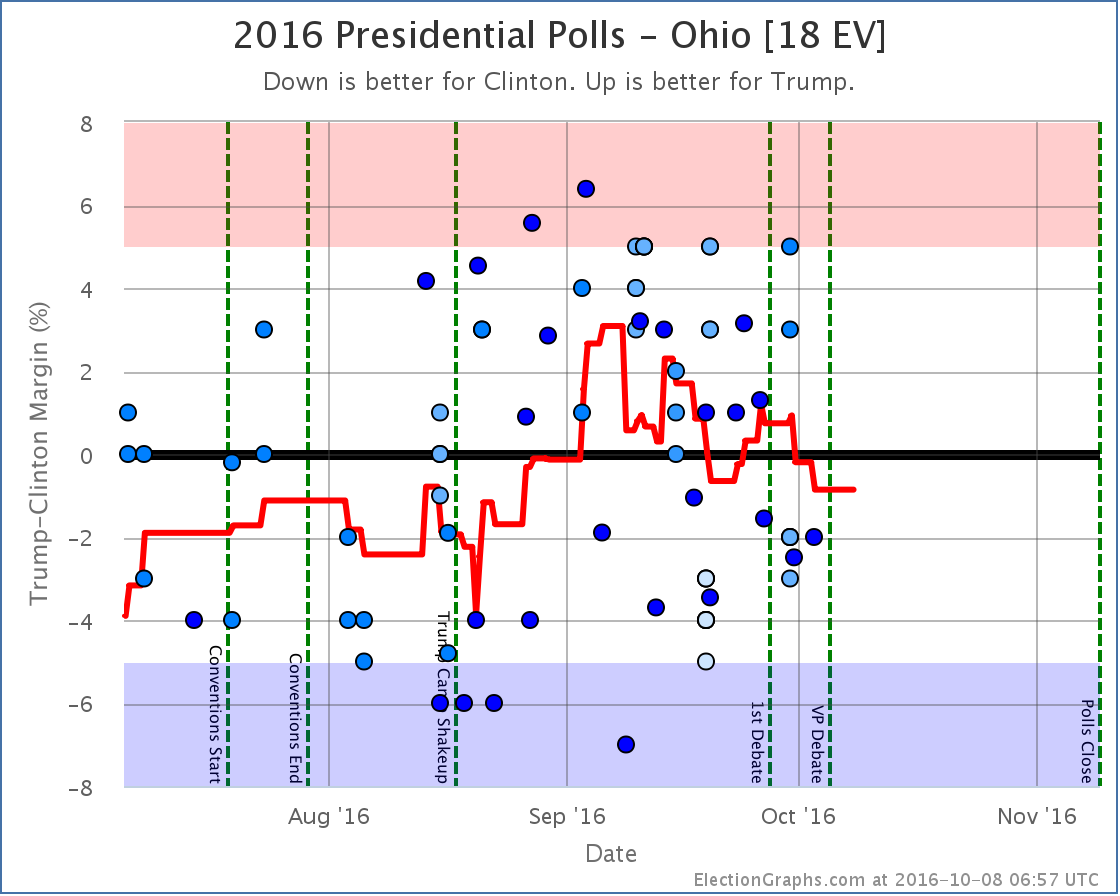
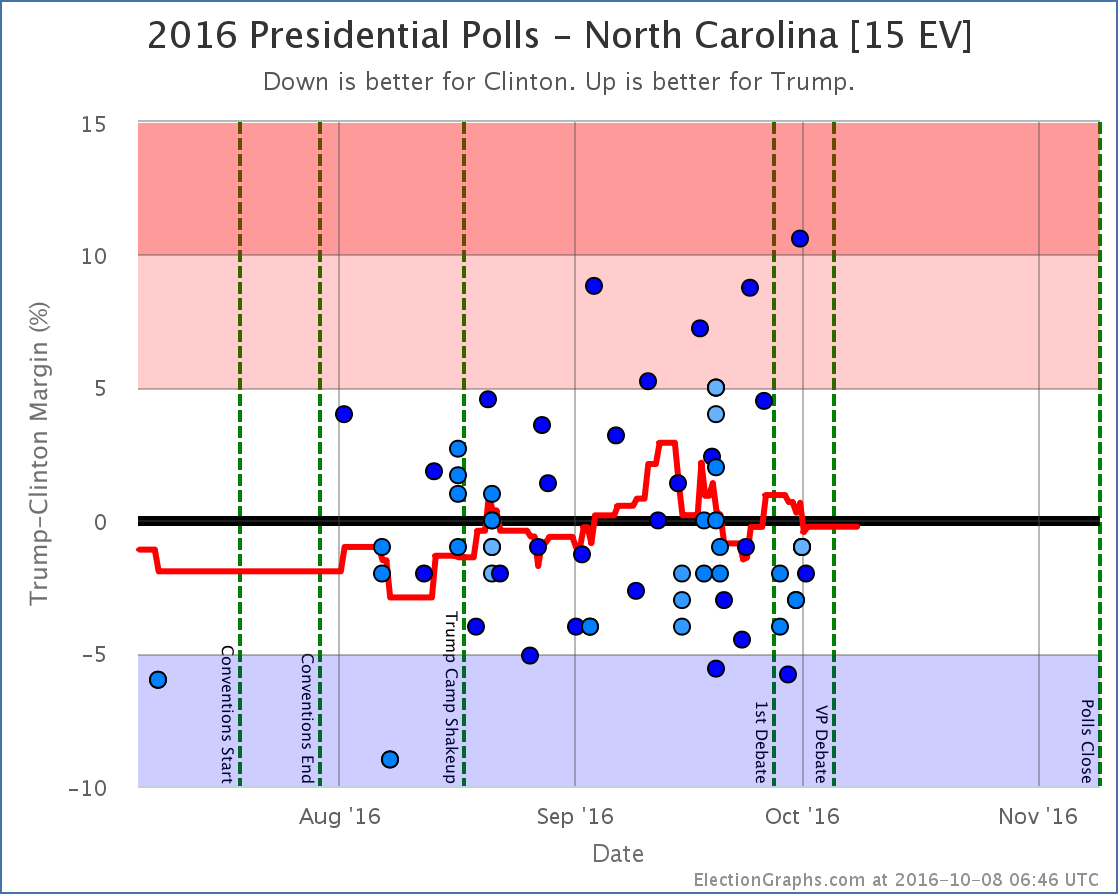
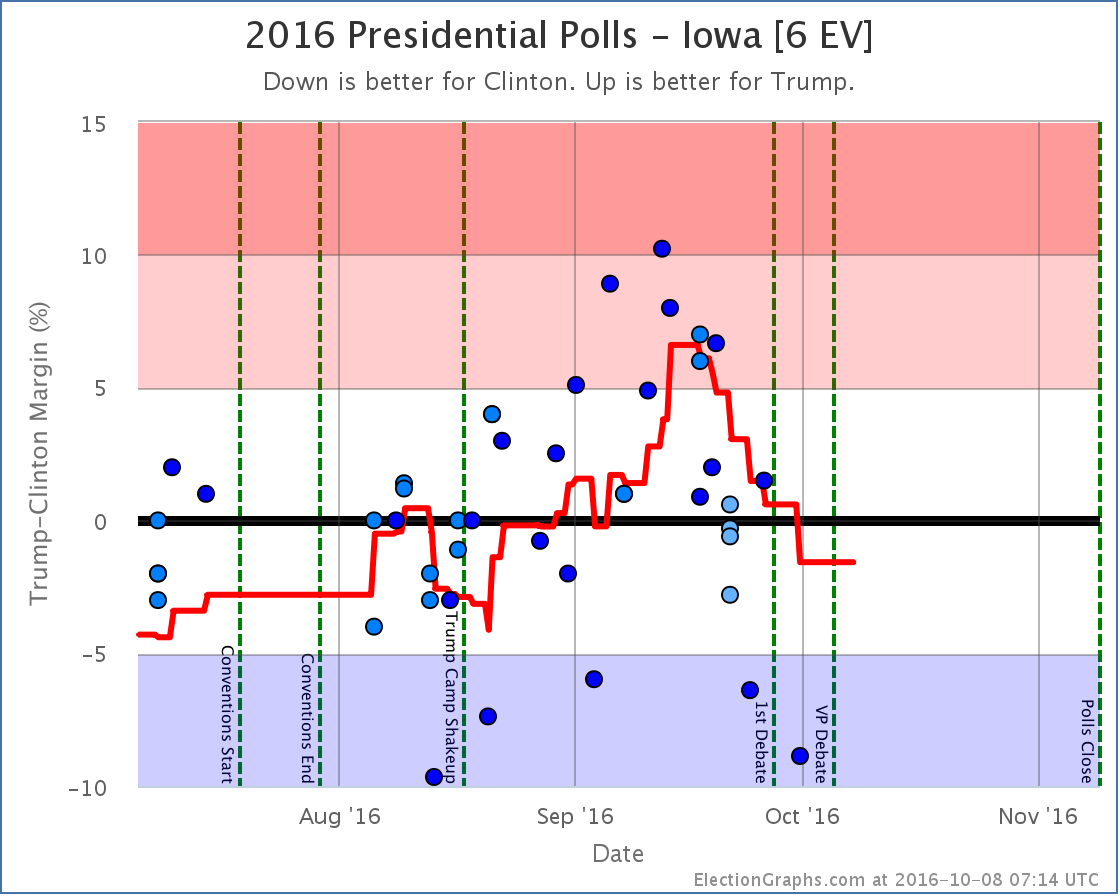
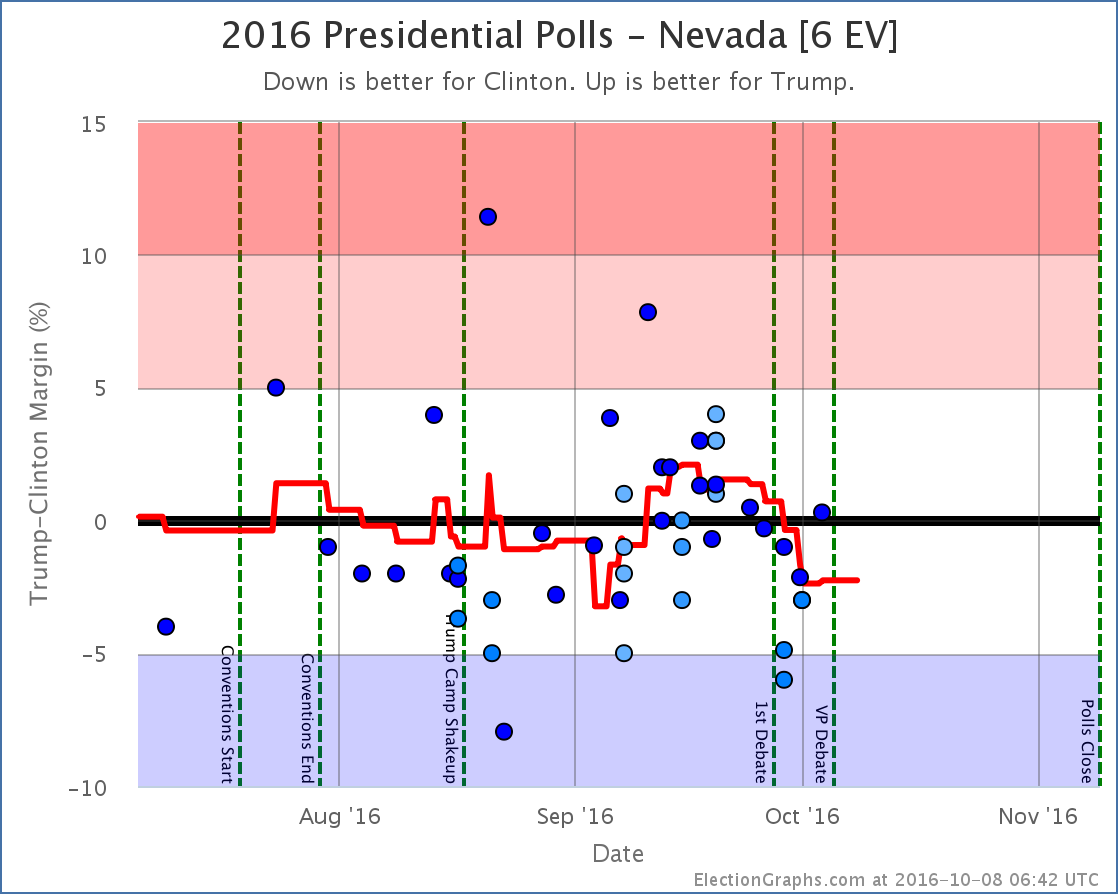
Moving out of reach for Trump
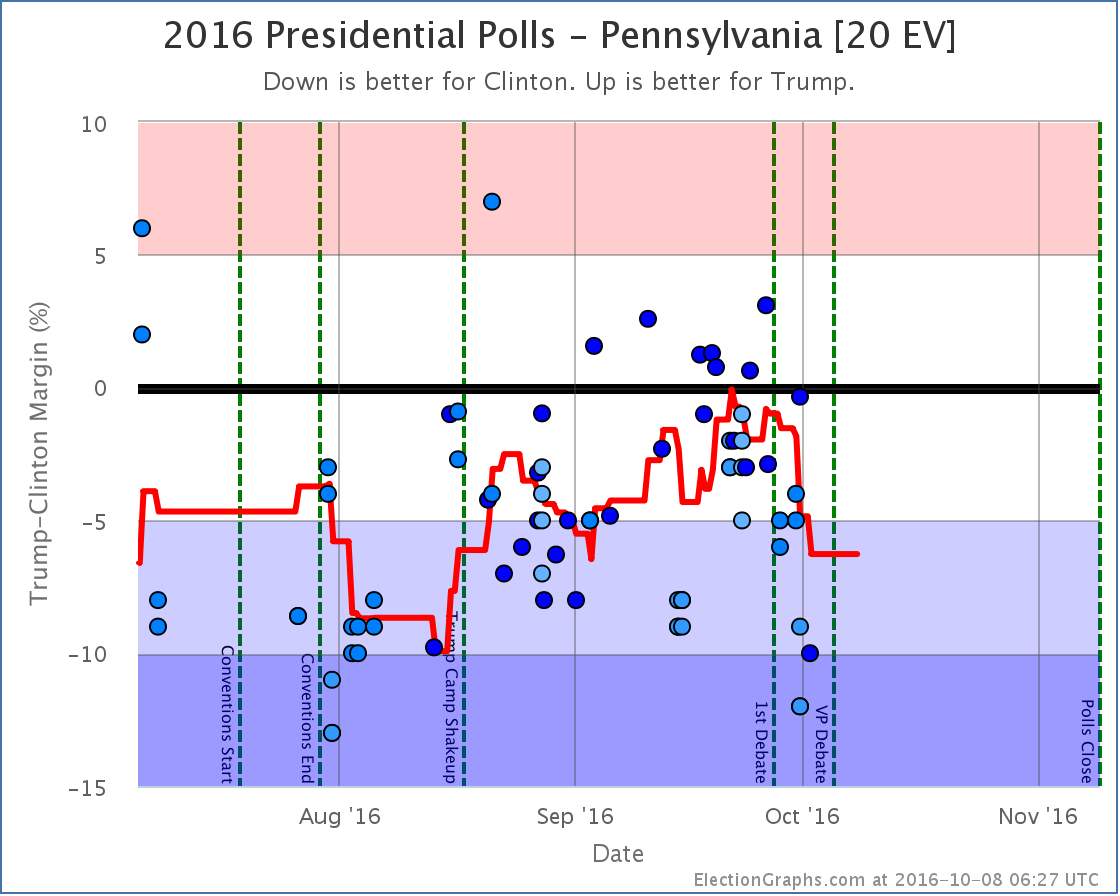
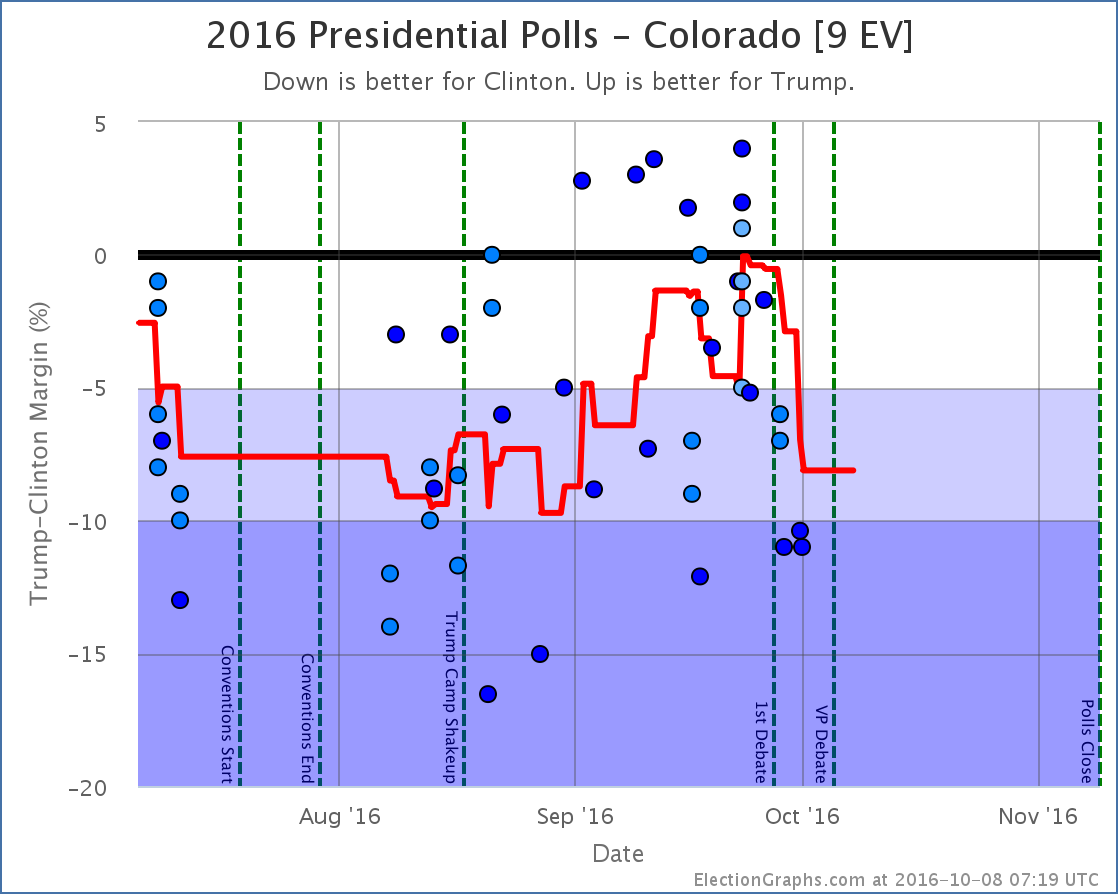
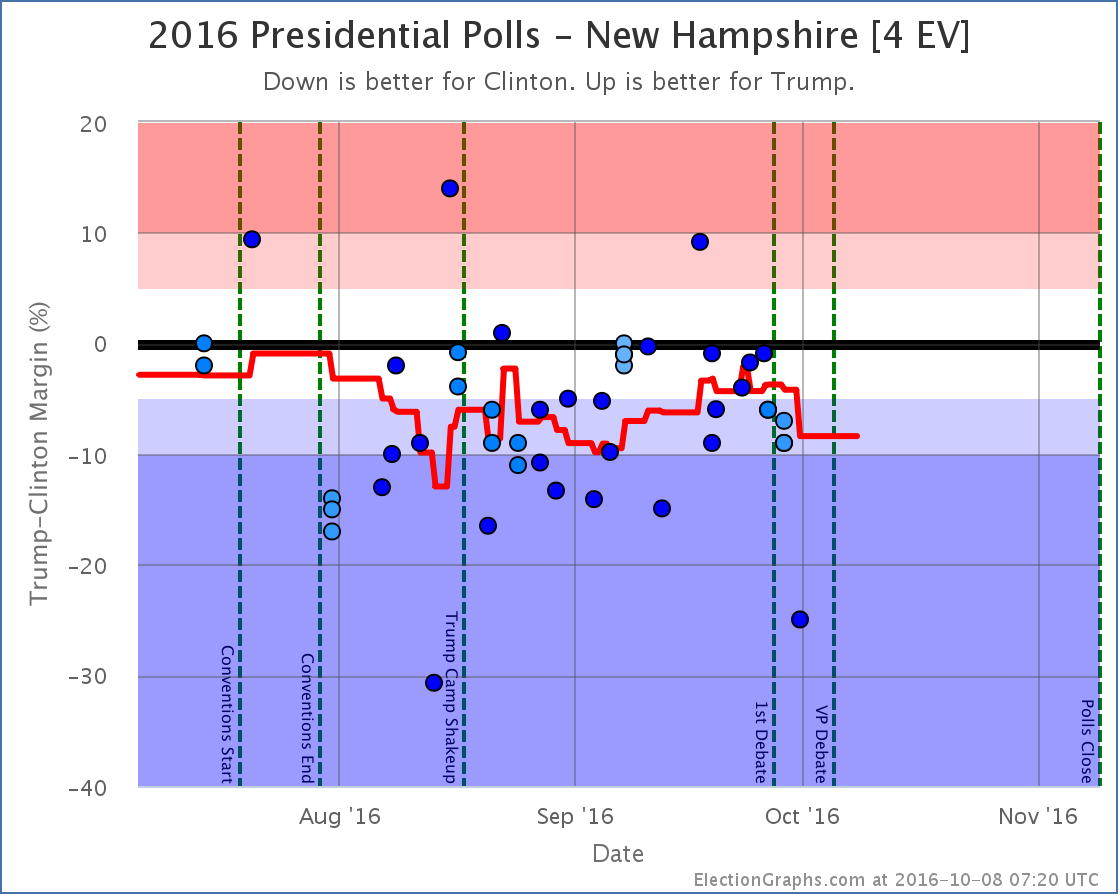
Moving out of reach for Clinton
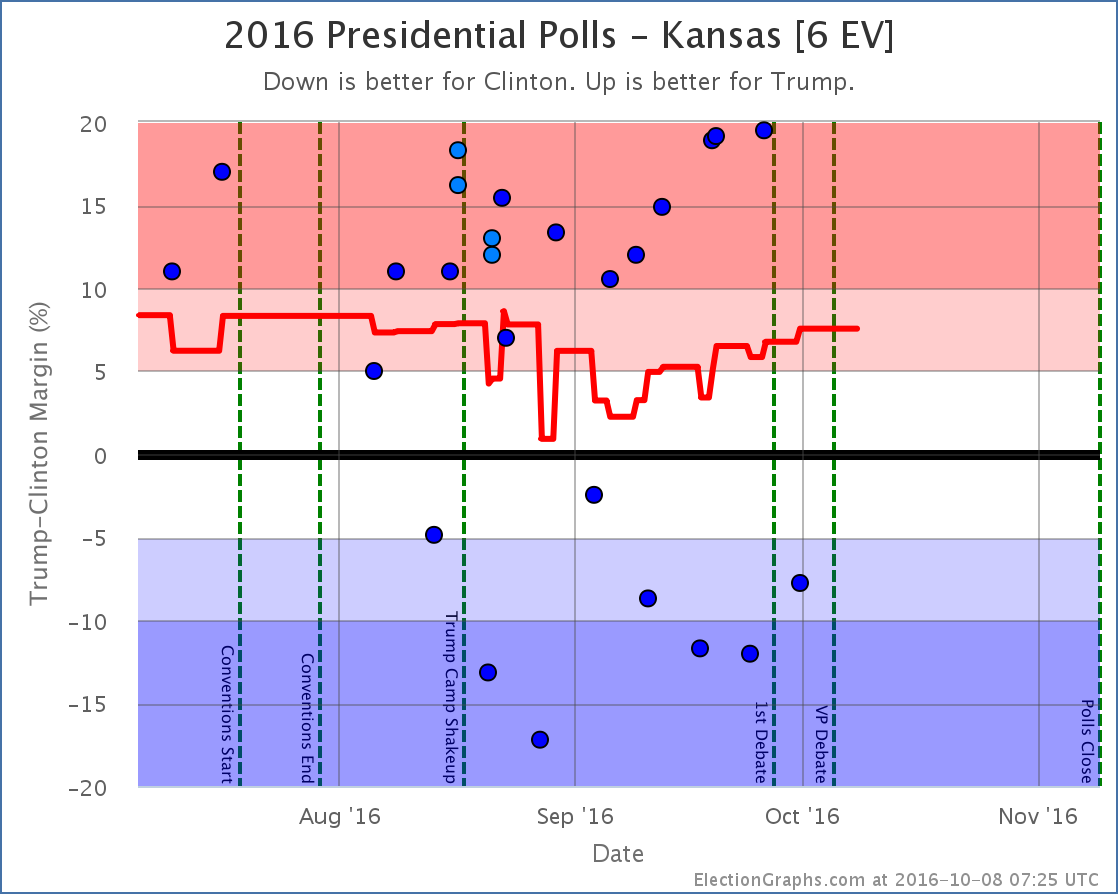
Moving into reach for Trump
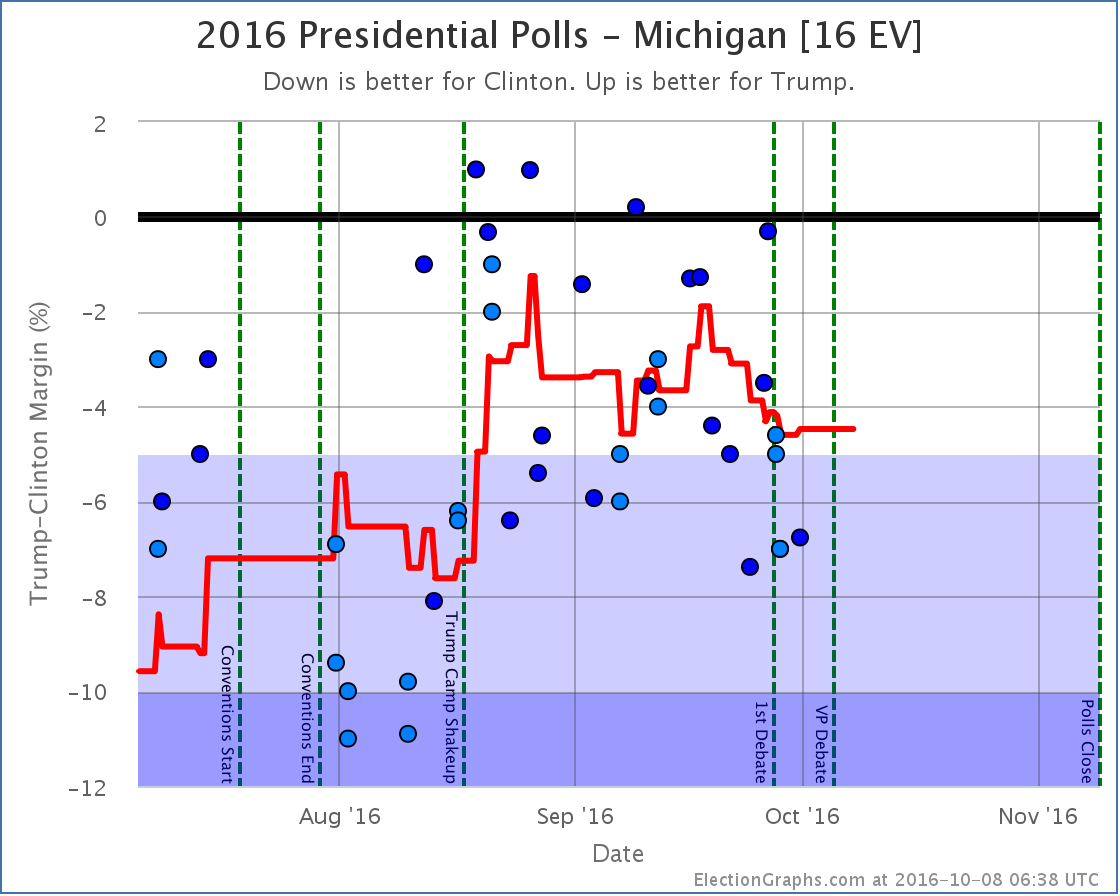
States that changed categories but then moved right back again
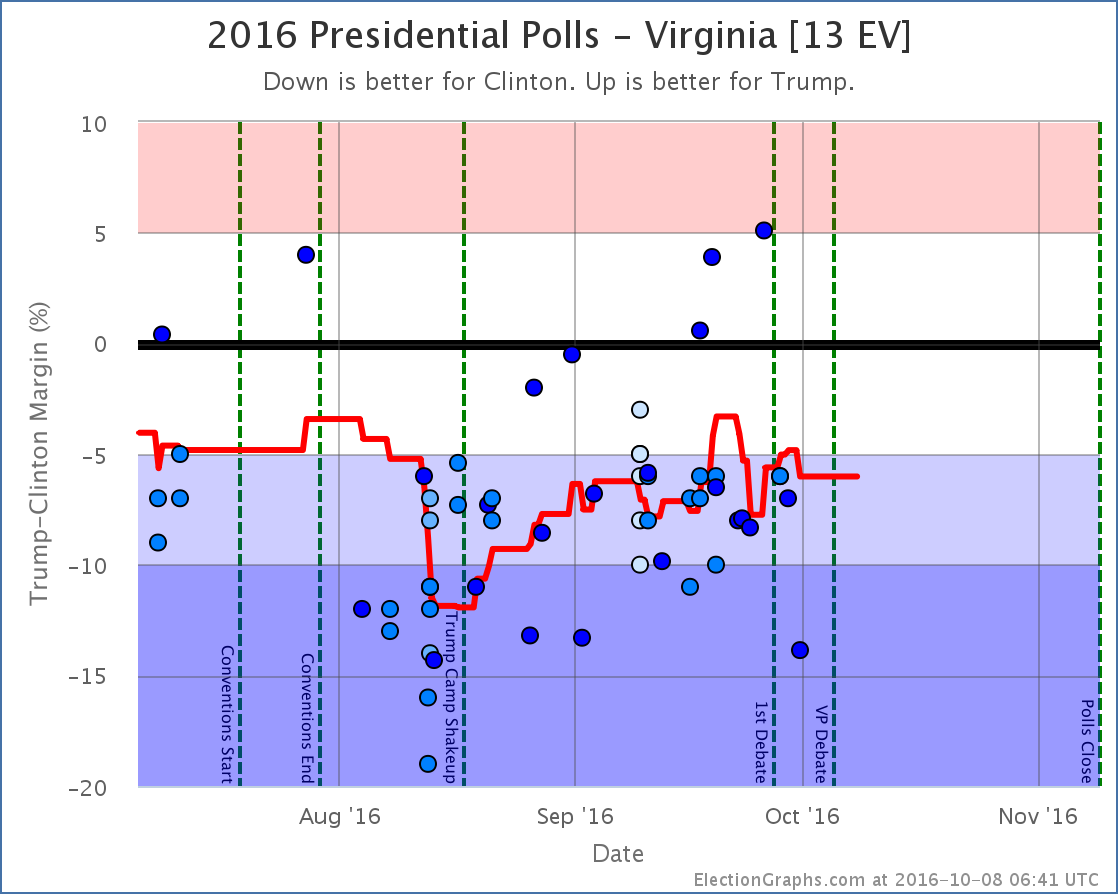
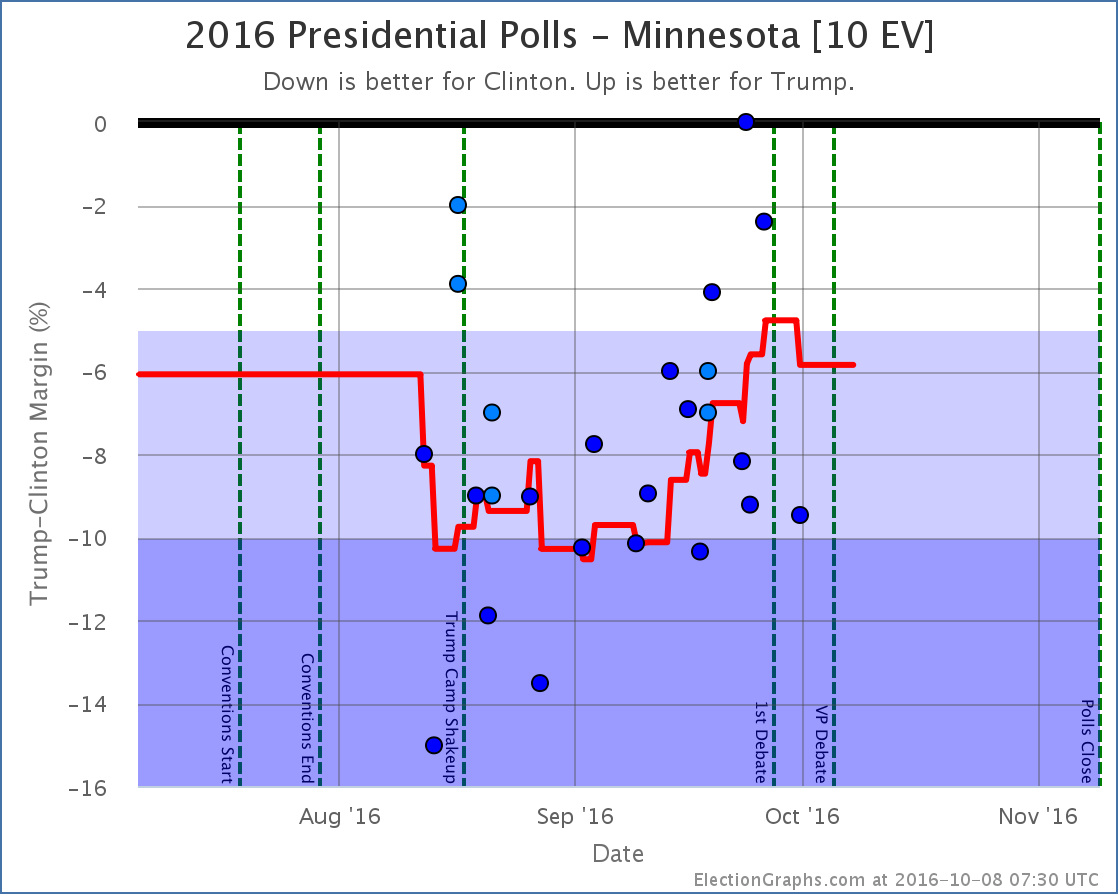
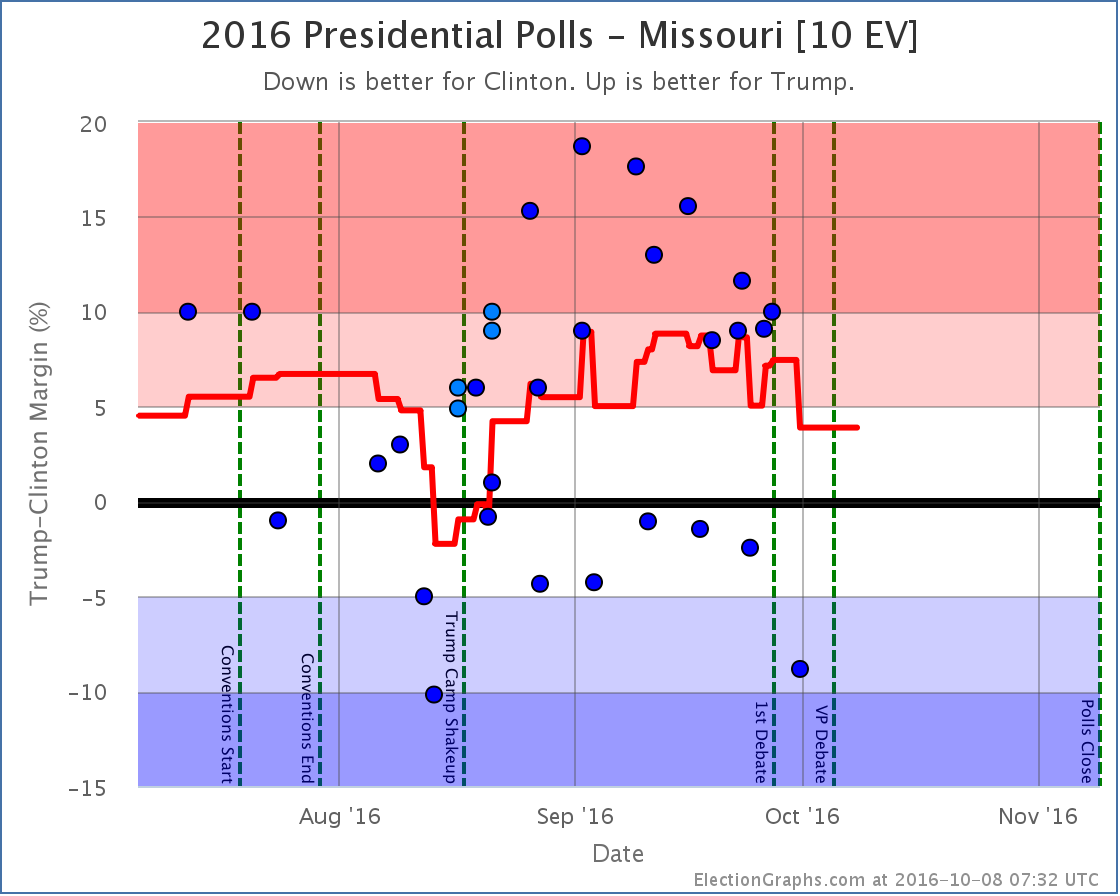
For more information…
This post is an update based on the data on ElectionGraphs.com. Election Graphs tracks both a poll based estimate of the Electoral College and a numbers based look at the Delegate Races. All of the charts and graphs seen in this post are from that site. Additional graphs, charts and raw data can be found there. Follow @ElectionGraphs on Twitter or like Election Graphs on Facebook to see announcements of updates or to join the conversation. For those interested in individual general election poll updates, follow @ElecCollPolls on Twitter for all the polls as they are added. If you find the information in these posts interesting or useful, please consider visiting the tip jar.
States with new poll data added since the last update: All 50 states, and DC. Notable changes in the tipping point plus New Mexico, Maine (at large), Kansas, and Missouri.
National Summary
With the latest batch of updates, there was a lot of churn that caused some big movements if you look at the charts. For a while as I entered polls it looked like Trump’s peak was definite and a clear downward trend was in place, even before the debate. But then as I continued to enter polls, most of those Clinton gains were reversed.
The primary reason for this? Florida [29 EV], Ohio [18 EV], and North Carolina [15 EV] are all currently very close in my averages. Close enough that single polls can move them back and forth across the center line. As I worked through this round of poll updates, all three of these states moved from Weak Trump to Weak Clinton and back again. Now, the actual changes in the averages in these three states were not much. They just happened to pass the zero line, and have large numbers of electoral votes.
So if you look at the “Expected Case” chart for the electoral college, you see a big move toward Clinton, then a big reversal a few days later. Because of the nature of the electoral college, you should expect (and be careful interpreting) large electoral college moves like this so long as there are big states that are close. In these cases looking at the tipping point provides a different view with a bit less volatility.
In any case, looking only at the final net change from this round of polls, we see these changes in the national picture:
- The expected case moves from Clinton by 8 EV to Clinton by 6 EV
- Clinton’s best case improves from Clinton by 188 EV to Clinton by 208 EV
- Trump’s best case declines from Trump by 106 EV to Trump by 92 EV
- The tipping point moves from Clinton by 0.1% in KS to Clinton by 1.3% in NH
Now, this round includes a handful of post-debate polls, but almost all of the movement discussed here comes from before the debate. (The exception is Florida returning to Weak Trump after the debate.)
Looking at the charts…
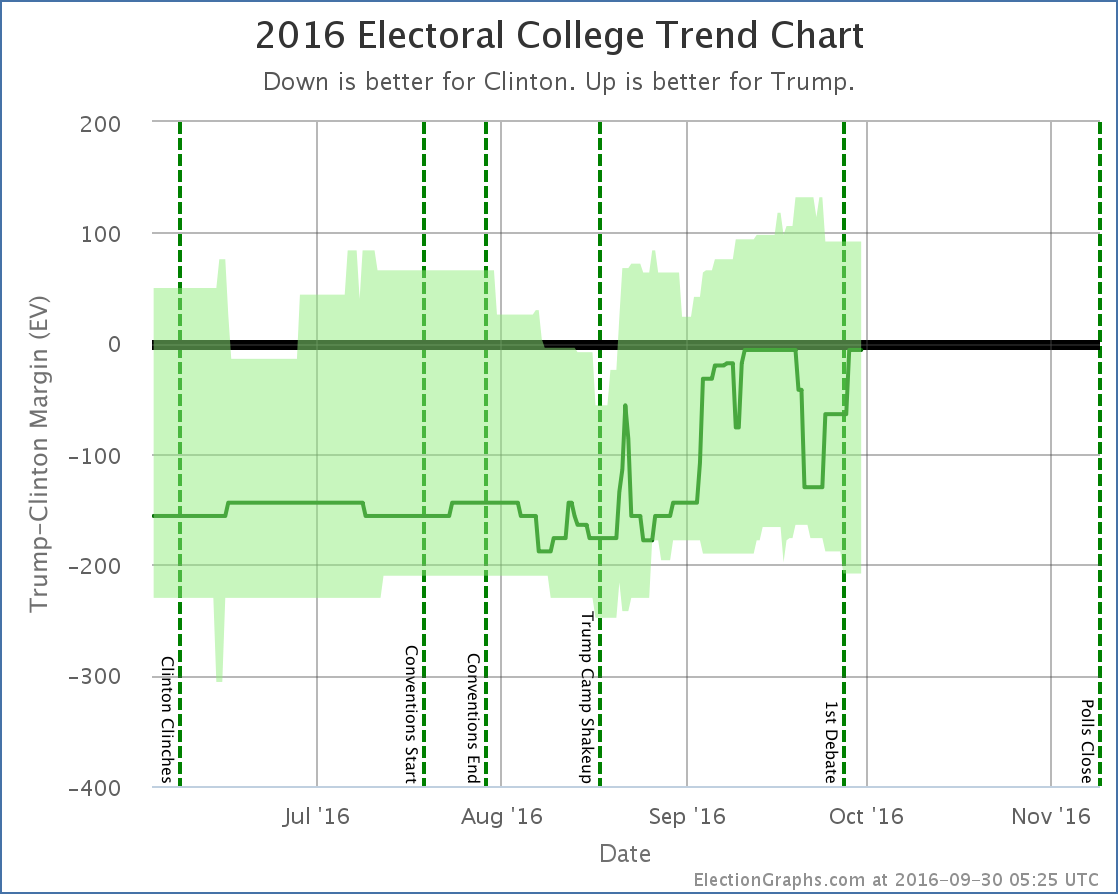
Notice the clear dip from about September 19th to September 28th when Florida, Ohio, and North Carolina went slightly blue, then moved slightly red again. In the end, the “expected case” remained flat. The movement Clinton saw from winning by 6 electoral votes to 8 electoral votes in the last update was erased by New Mexico and Kansas both returning to their “normal” colors.
Both “best cases” moved toward Clinton though, with New Mexico and Maine at large both moving out of Trump’s reach, while Missouri moved into Clinton’s reach.
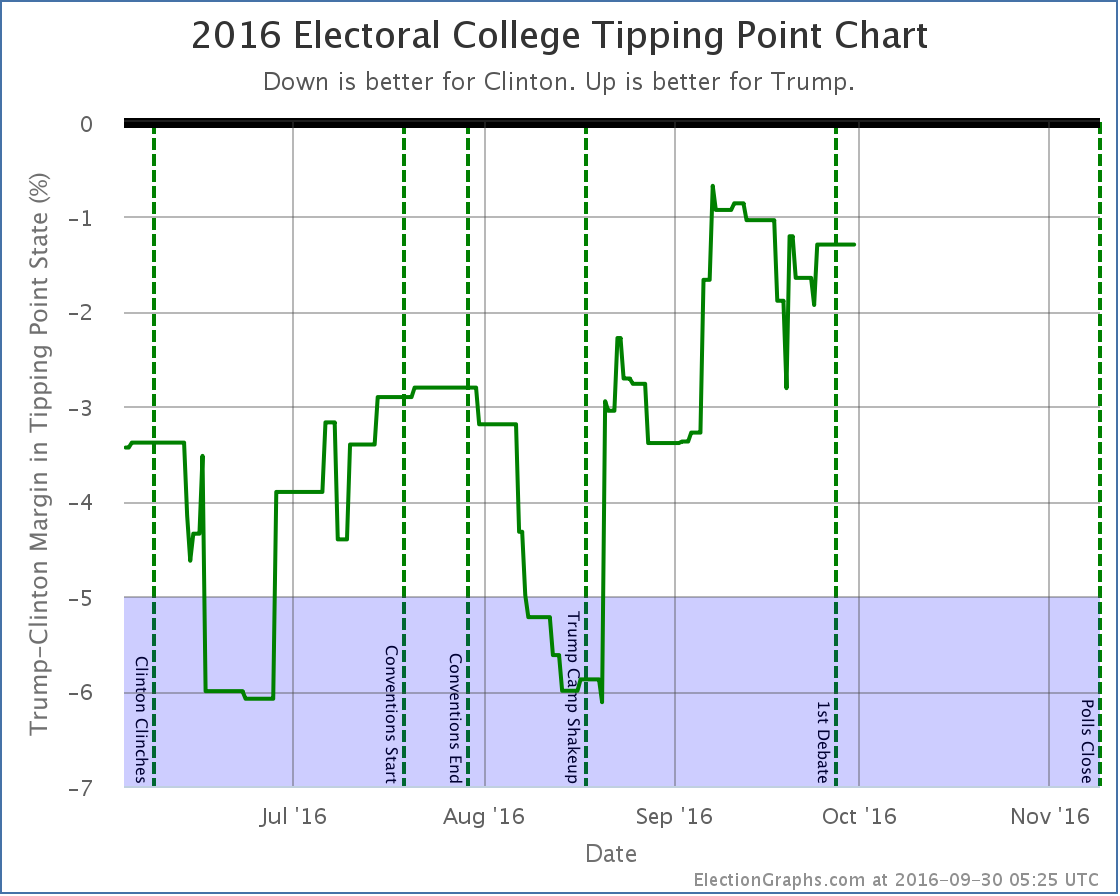
The tipping point chart doesn’t end up with huge moves when big states cross the center line, so it might be a better chart to look at right now to see how the race is moving. What we see is that after big gains starting with Trump’s campaign shakeup on August 17th, Trump seems to have peaked around September 7th… way up from where he had been, but never actually taking the lead… and he has been on a slow decline ever since… but we haven’t yet seen a BIG move back toward Clinton.
By most reports, Trump did badly in the debate, and has been doing things counter-productive to his campaign since the debate. But this does not mean large numbers of people have changed sides. Maybe this will happen, maybe it won’t, but the small number of post-debate polls already included here don’t yet show it. (In fact, as I mentioned, the single state category change post-debate so far is a move toward Trump.)
Additional post-debate polls are coming in quickly now, but I had to cut off the round poll updates somewhere to get this blog post out. There will be another update soon enough, and we’ll start to see a bit better what (if any) lasting change comes out of the first debate. Of course just about as soon as there has been enough time to see that in the polls, it will be time for the next debates…
39.4 days left until polls start to close.
State Details
For those digging into the details, here are the charts for all the states influencing the analysis above:
The big close states:
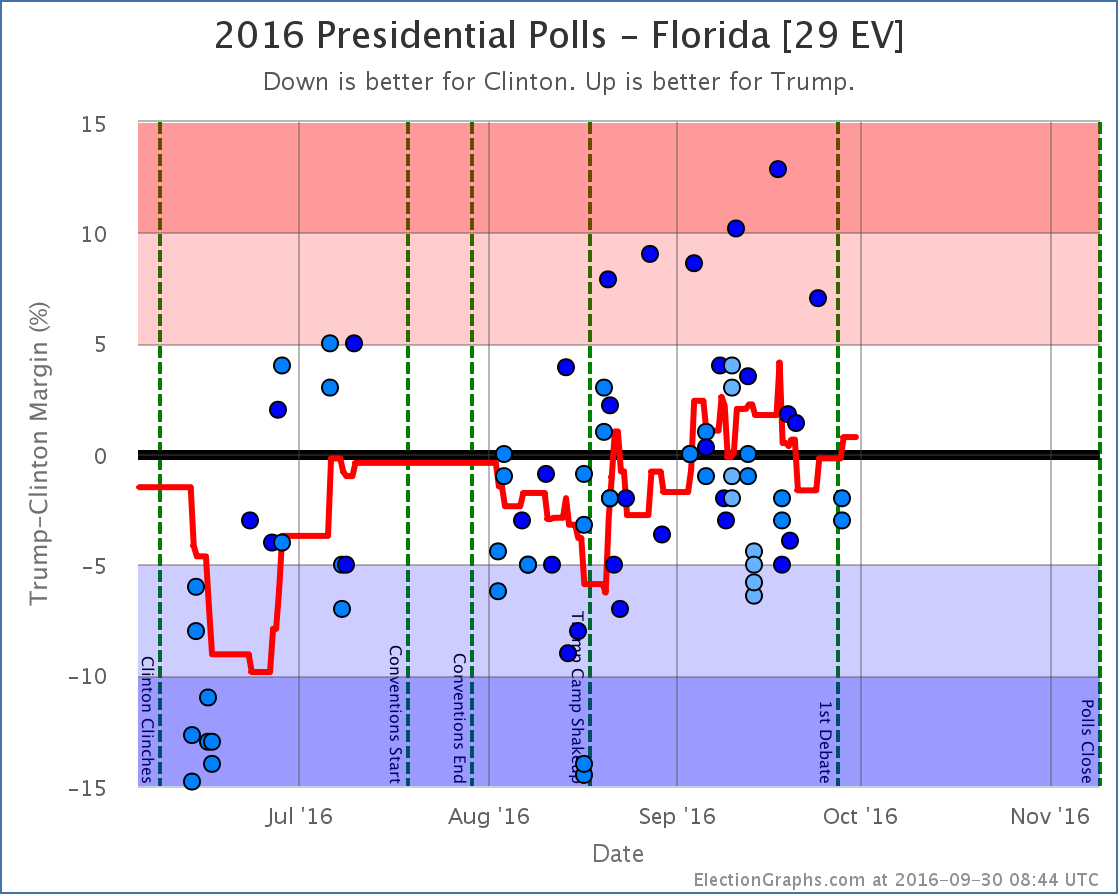
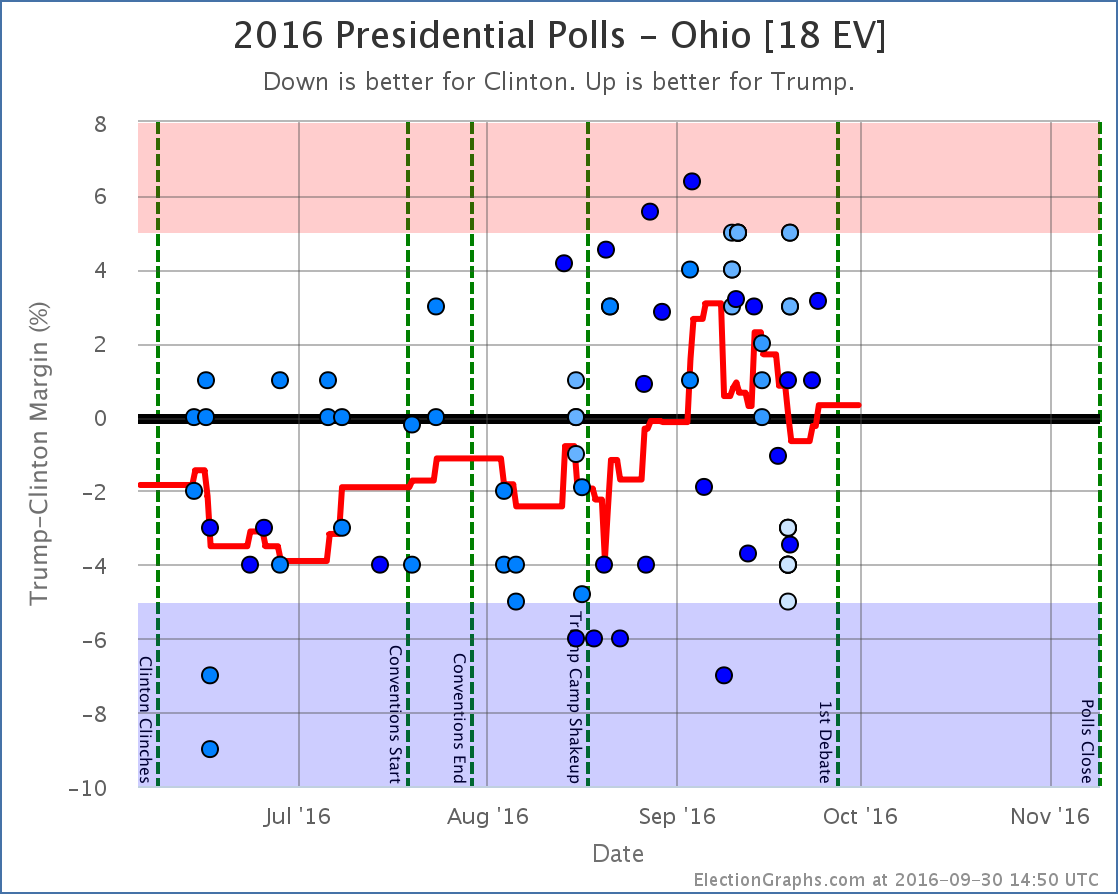
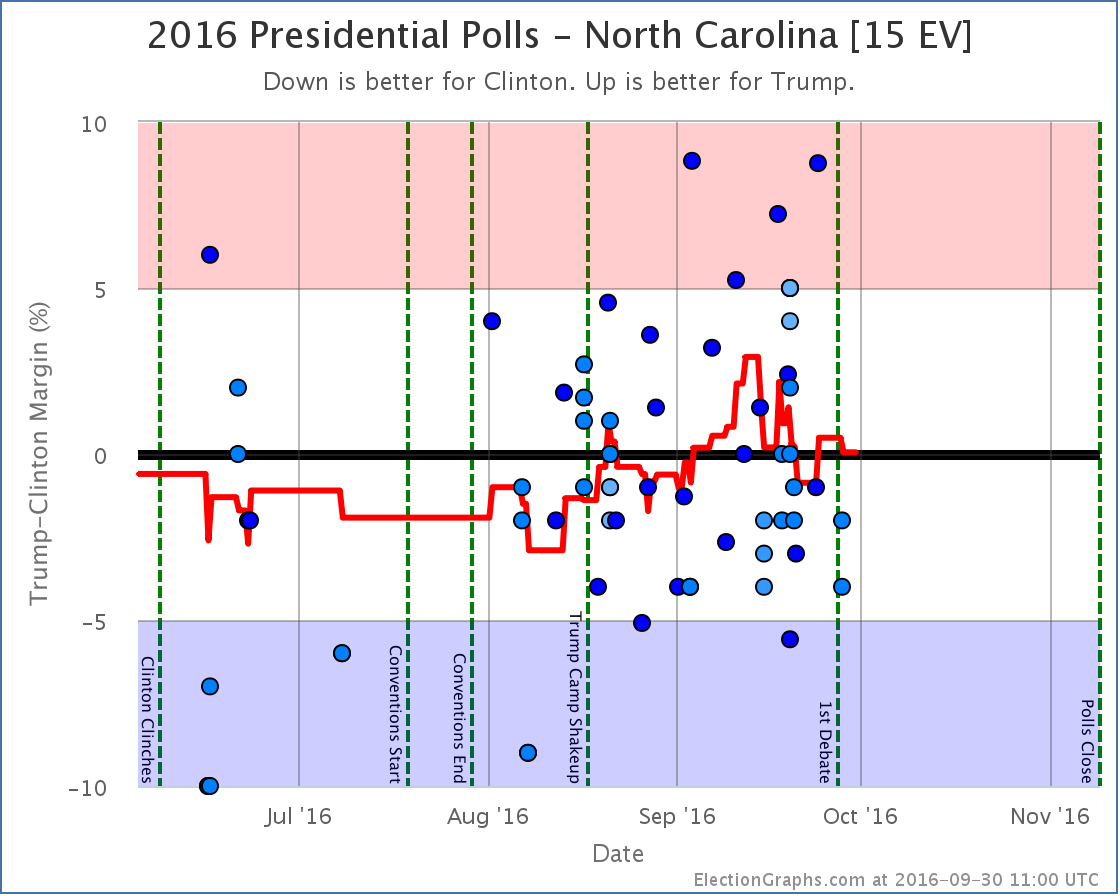
Weak Clinton to Weak Trump
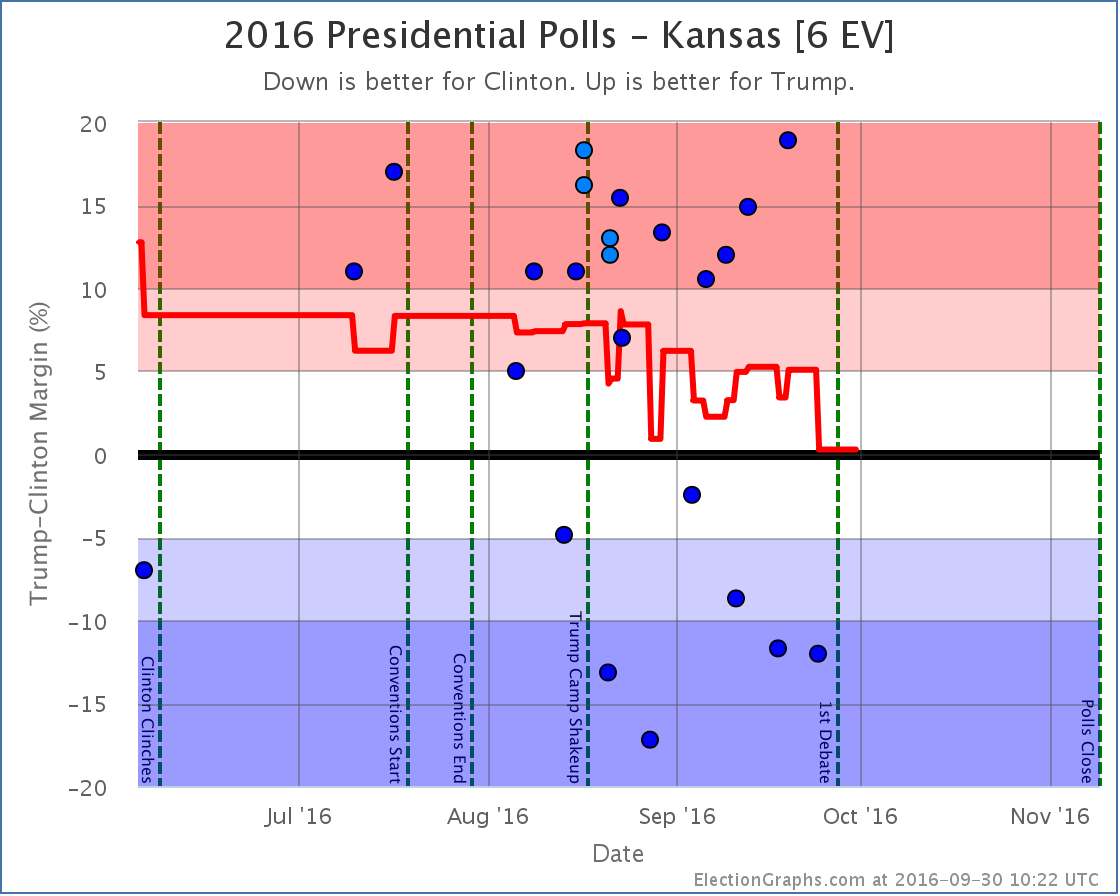
Strong Trump numbers from Ipsos and CVoter balance out the strong Clinton numbers from Google and leave us with an essentially tied Kansas and erase the short blue period for the state I noted last time. (The Ipsos and CVoter results came out later, but covered an earlier time period, so they moved the lines in the past, not just the current number.)
As I stated last time I am incredulous about the Google numbers, and wish there was more additional polling in Kansas to clear up what is really going on there.
Weak Trump to Strong Clinton
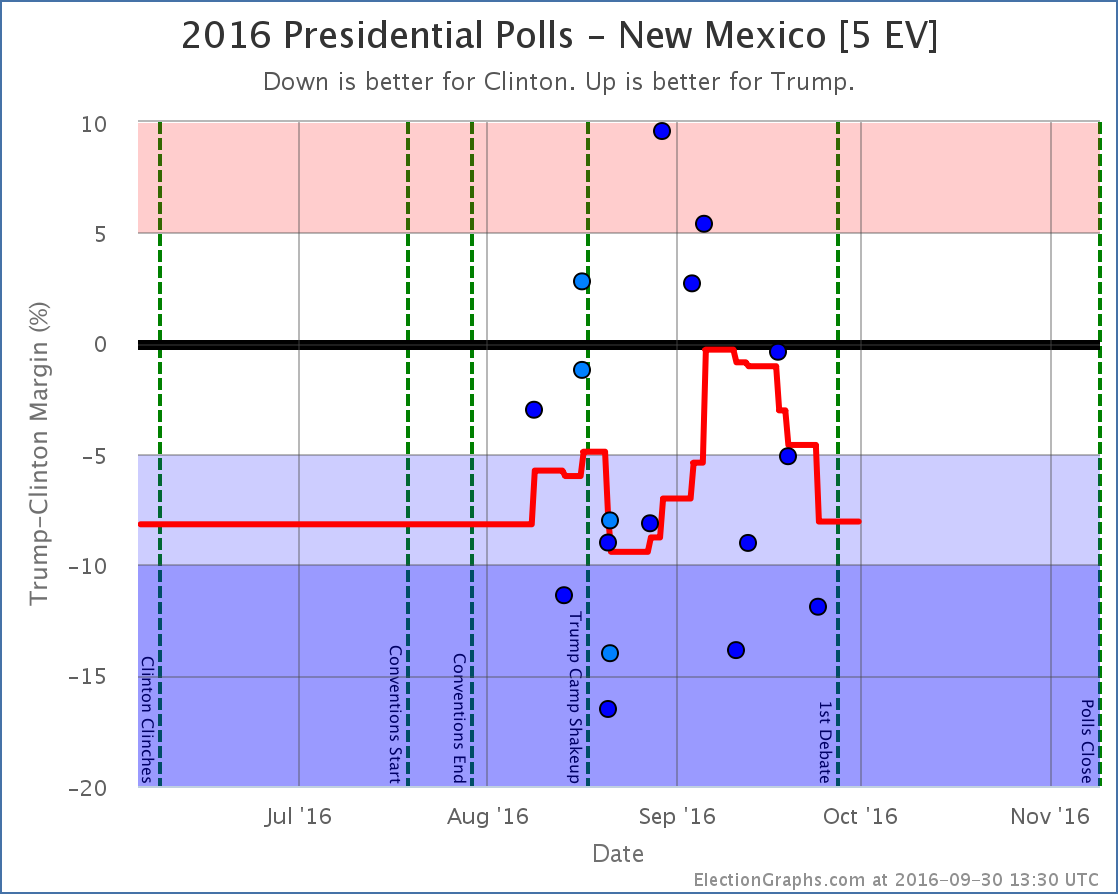
New polls in New Mexico erased the short foray into red territory for New Mexico. As with Kansas, since some of the “new” polls covered older date ranges, the shape of the curve in the past changed as well as the current number.
Strong Trump to Weak Trump
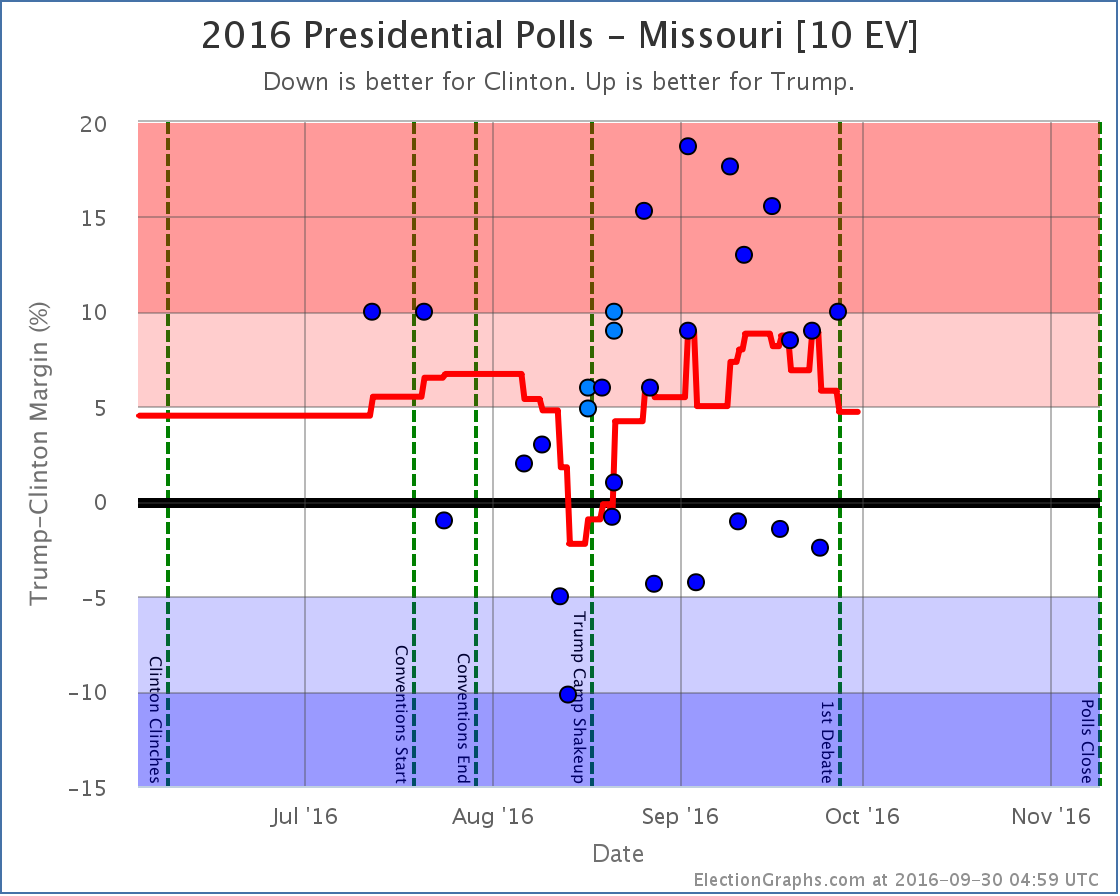
Weak Clinton to Strong Clinton
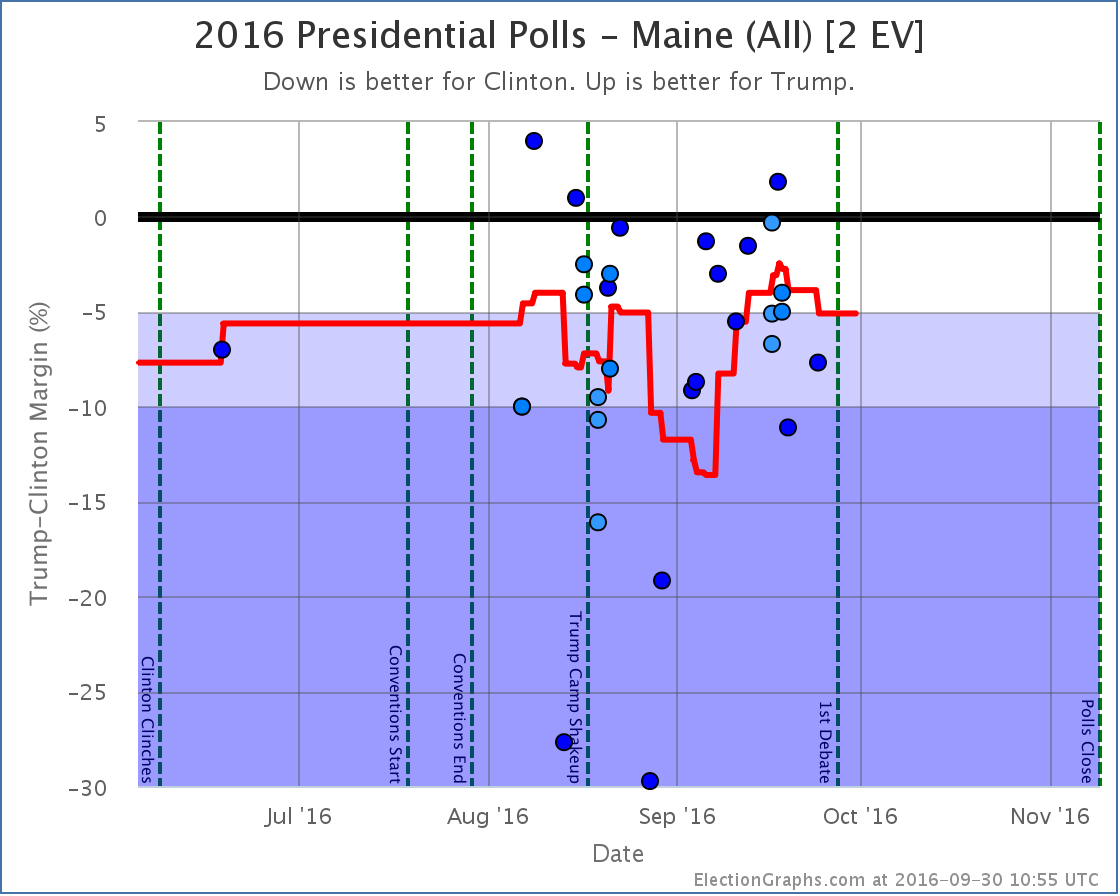
Other states that influenced the Tipping Point
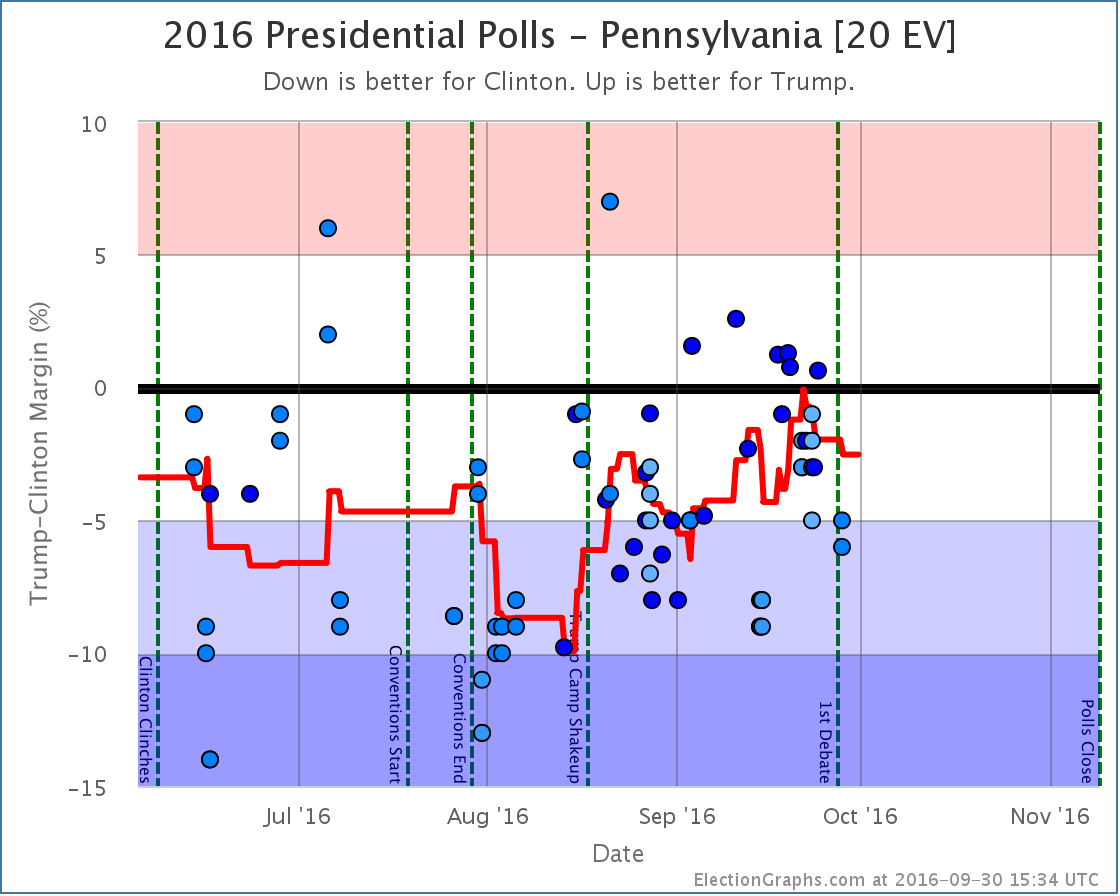
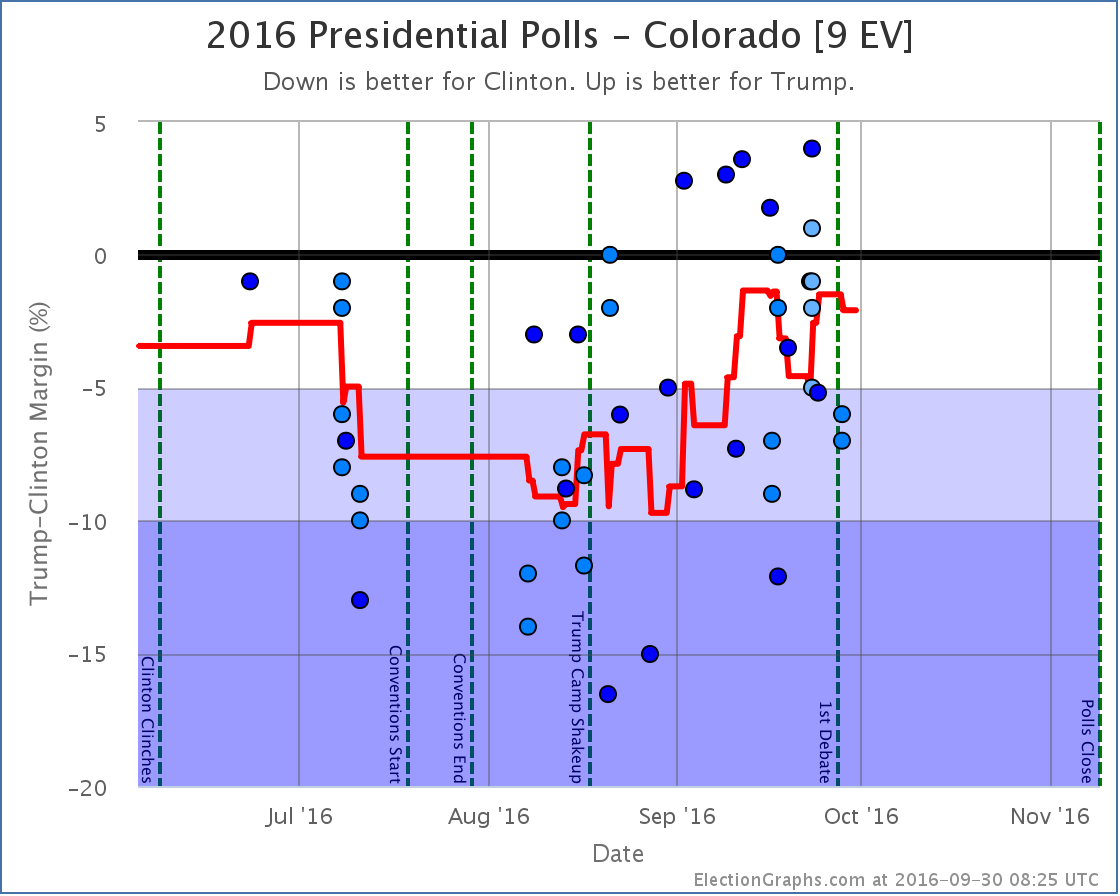
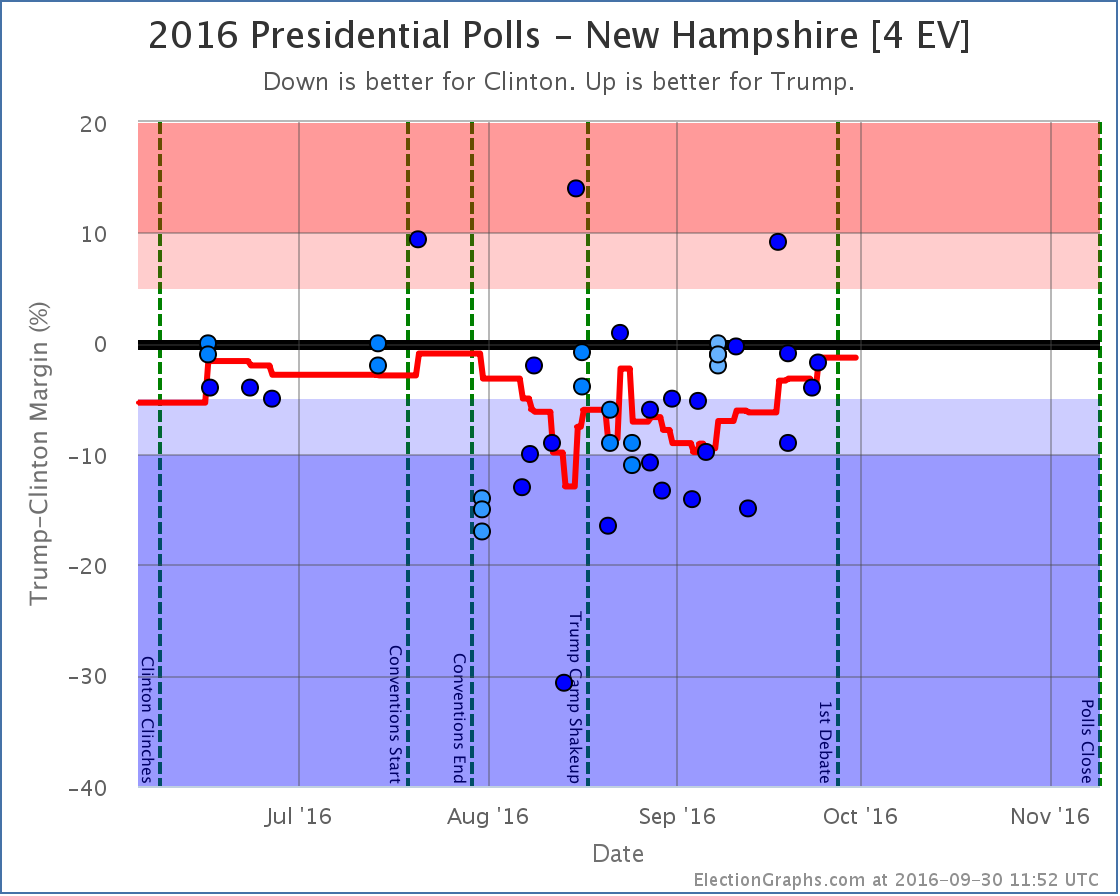
Note on placing polls on the timeline
I somehow forgot to mention this in my recent interview about this site, but it seems relevant to the discussion above… Many other election tracking sites place polls based on the END of the poll’s time in the field. I place polls on the timeline based on the mid-date of their time in the field. I think this does a better job at trying to identify when directional changes happen, because if an event and a mid-date are aligned, you know that the poll was half before and half after the event. When you place polls by the end of their field time, you can’t make any sort of statements like that about how the poll results match up with the event without referring to the specific start and end dates.
For more information…
This post is an update based on the data on ElectionGraphs.com. Election Graphs tracks both a poll based estimate of the Electoral College and a numbers based look at the Delegate Races. All of the charts and graphs seen in this post are from that site. Additional graphs, charts and raw data can be found there. Follow @ElectionGraphs on Twitter or like Election Graphs on Facebook to see announcements of updates or to join the conversation. For those interested in individual general election poll updates, follow @ElecCollPolls on Twitter for all the polls as they are added. If you find the information in these posts interesting or useful, please consider visiting the tip jar.
Edit 2016-10-01 00:34 UTC to correct the one state that moved after the debates. I had said it was North Carolina moving back from Weak Clinton to Weak Trump, it was actually Florida.
States with new poll data added since the last update: All 50 states, plus the Maine congressional districts. Notable changes caused by Colorado, Florida, Missouri, New Hampshire, Maine (CD2), and South Carolina.
There were a ton of changes with this batch of new polls. Four of the changes favored Trump, two favored Clinton. We’ll look at each of these in order. The “good for Trump” states first, then the “good for Clinton” states, then we’ll review the net national changes due to all of these together.
Good for Trump
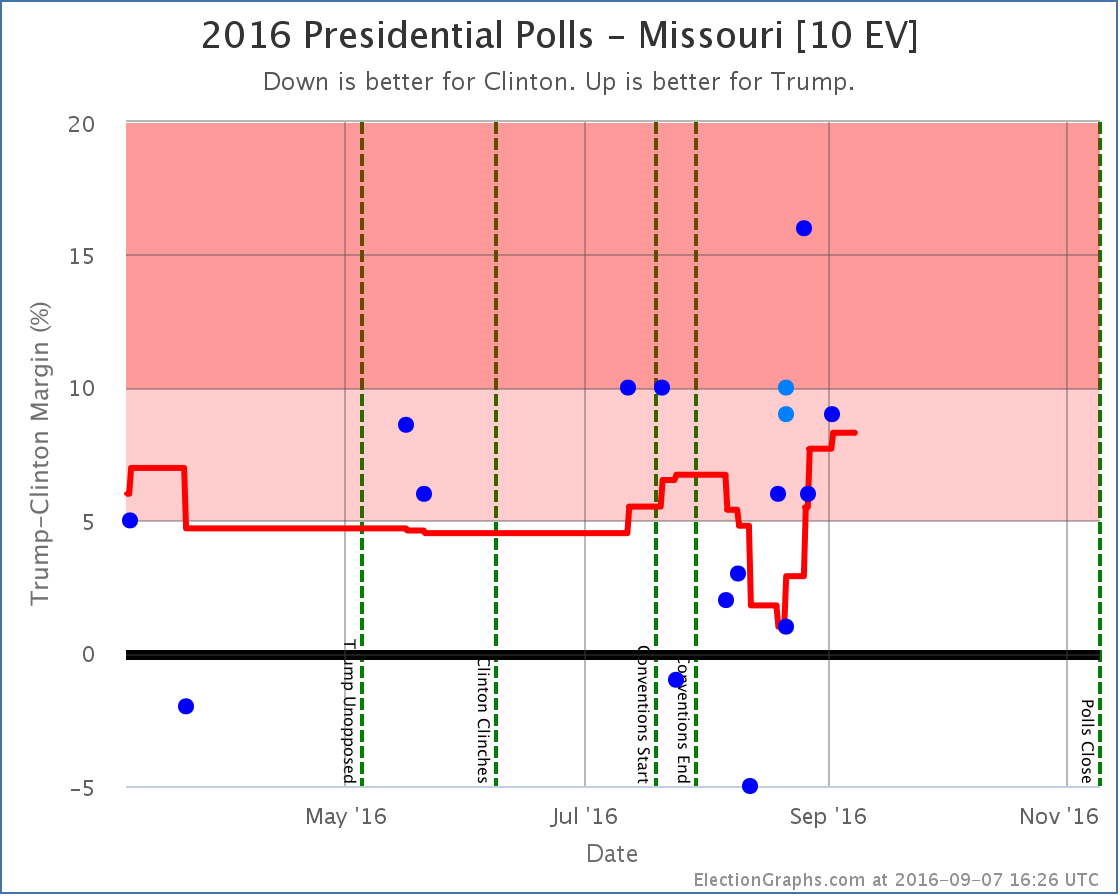
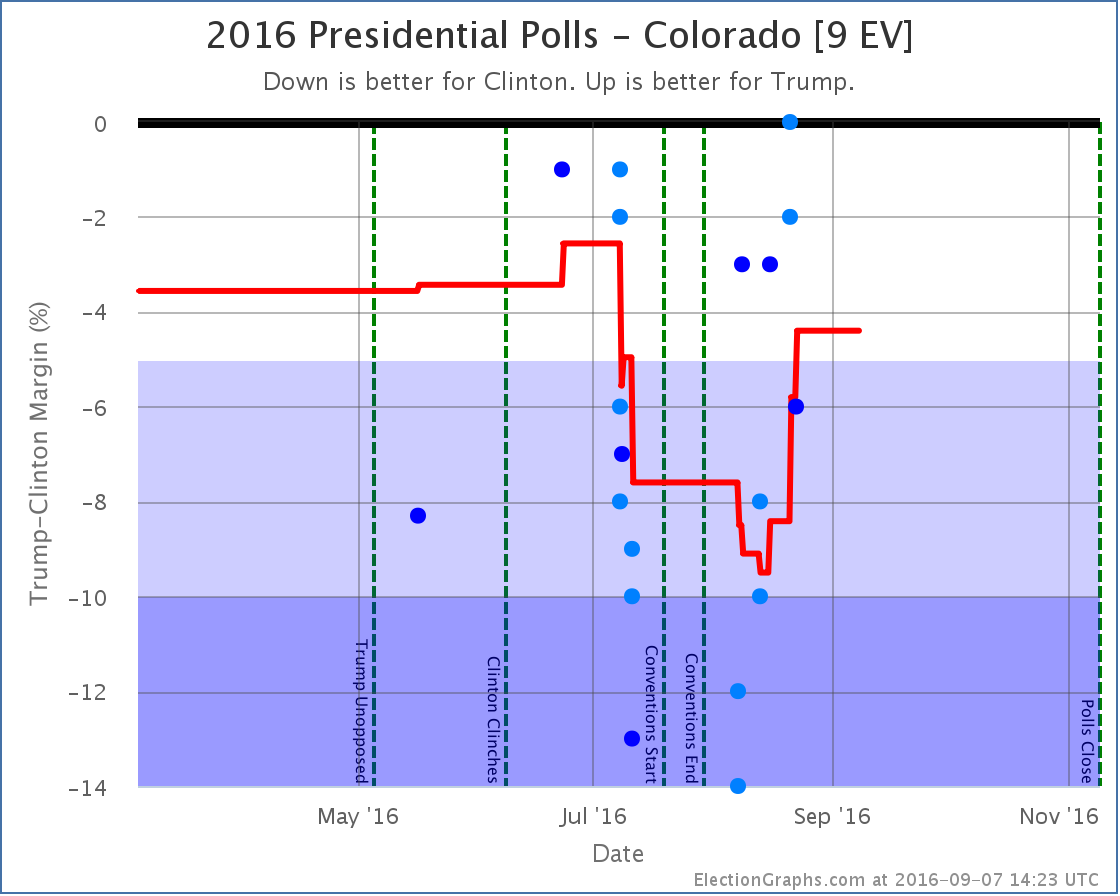
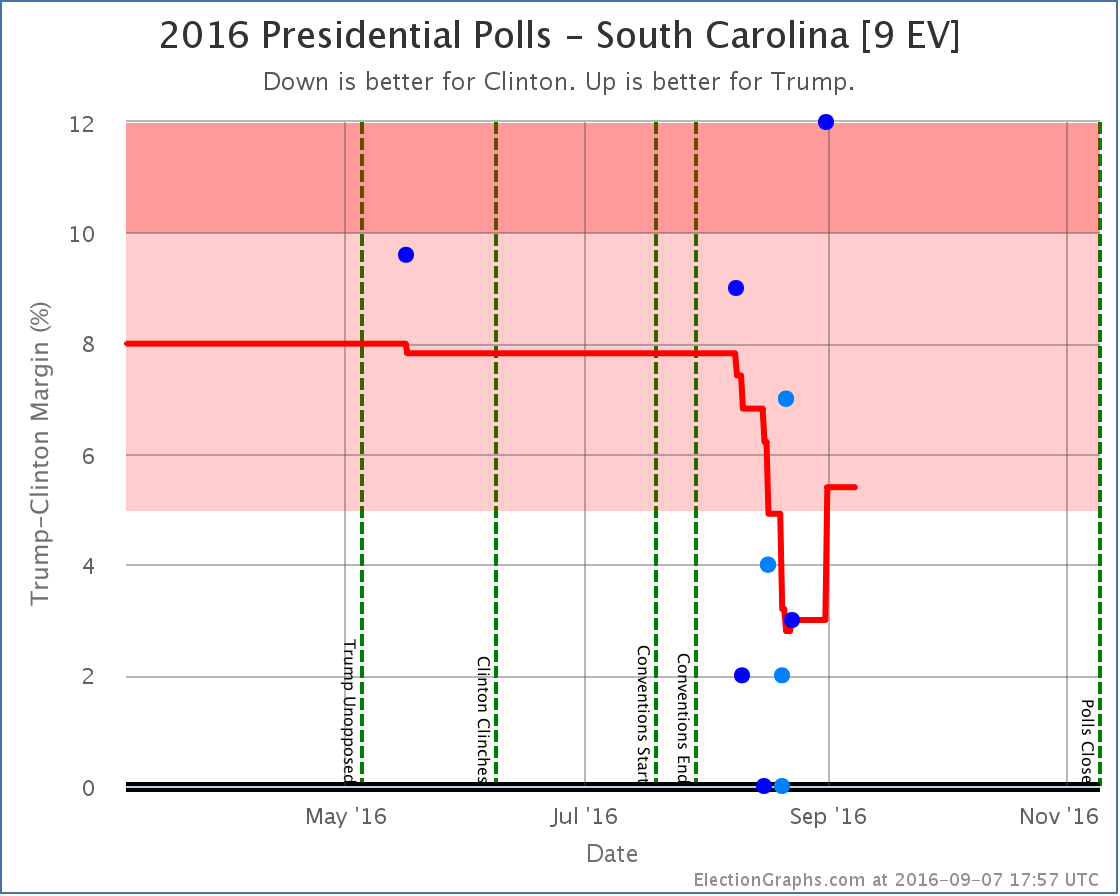
Missouri, Colorado and South Carolina all show the same general pattern… a Trump decline bottoming out in mid-August, followed by a Trump recovery. The specifics of the patterns are slightly different, but the dip followed by a rebound looks clear. (Although the rebound in South Carolina may turn out to be due to an outlier.)
Missouri and South Carolina had looked like states where Clinton was making it close, Trump now pulls them out of reach again. Meanwhile Clinton’s lead in Colorado looked like it was not at risk for her, but the last few polls show Trump making it close again.
So winning Missouri and South Carolina are no longer part of Clinton’s best case, while the possibility of winning Colorado is now included in Trump’s best case.
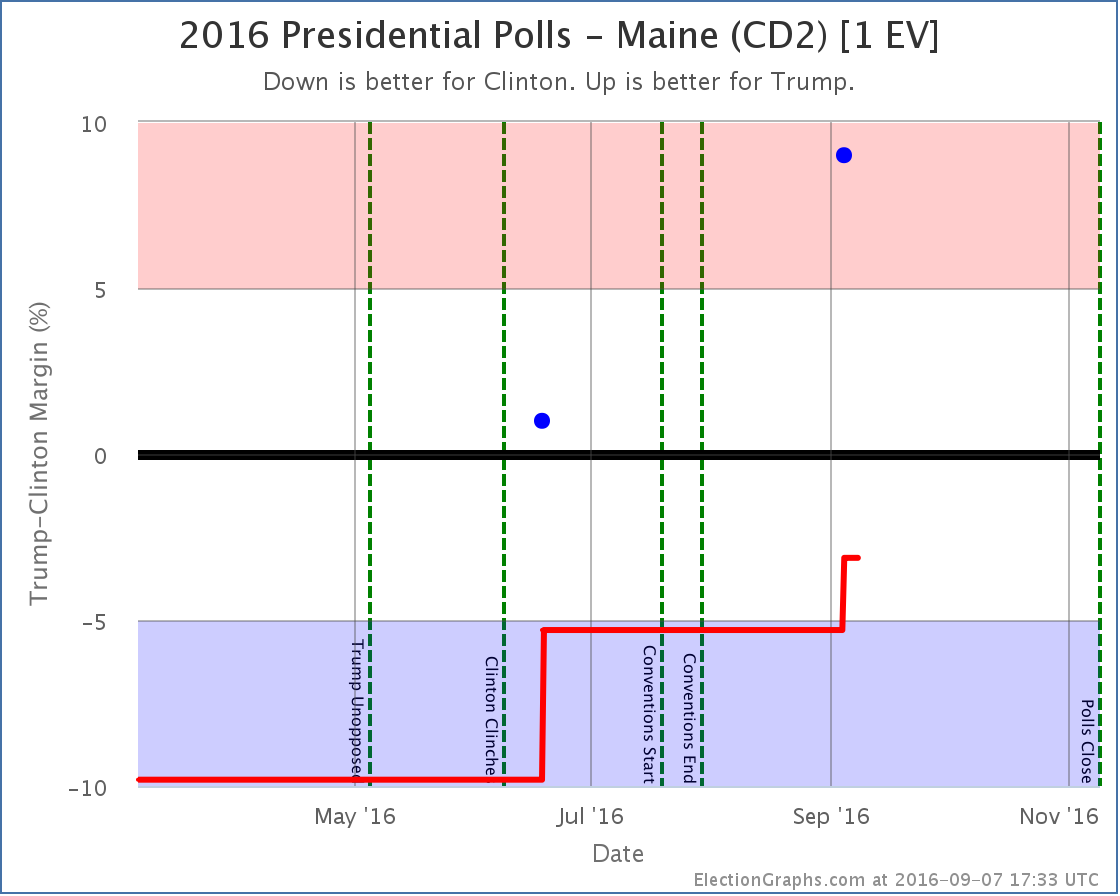
Maine and Nebraska are the only two states that can split their electoral votes. So far Nebraska has not been polled at all at the congressional district level. This week brings only the second time the Maine congressional districts have been. In both cases, the overall numbers for the states have moved toward the center line past all of the congressional districts. Mathematically, the state as a whole can’t be closer than all the parts making up the state, so we know this is wrong, but without congressional district polling, we can’t tell where the congressional districts should be.
In Maine, with the new CD2 polling result, we now have two polls showing Trump ahead. These are the only two polls. The average is filled out with the Maine CD2 results from 2004, 2008, and 2012. Given the strong Democratic wins in CD2 in those years, the two polls from this year aren’t quite enough for the poll average to flip the district to Trump, but the average now only has Clinton up by 3.1%, so we now consider Maine’s 2nd District to be a possible pick up for Trump.
Even with this new poll, Maine-CD2 is what I consider to currently be the “most needed poll” (followed by NE-CD2, NE-CD1, SD, and ME-CD1). Please pollsters! More congressional district level coverage of both Maine and Nebraska! They both look like they have a possibility of splitting this cycle. We need more polling to understand just how likely (or not) that possibility actually is!
Good for Clinton
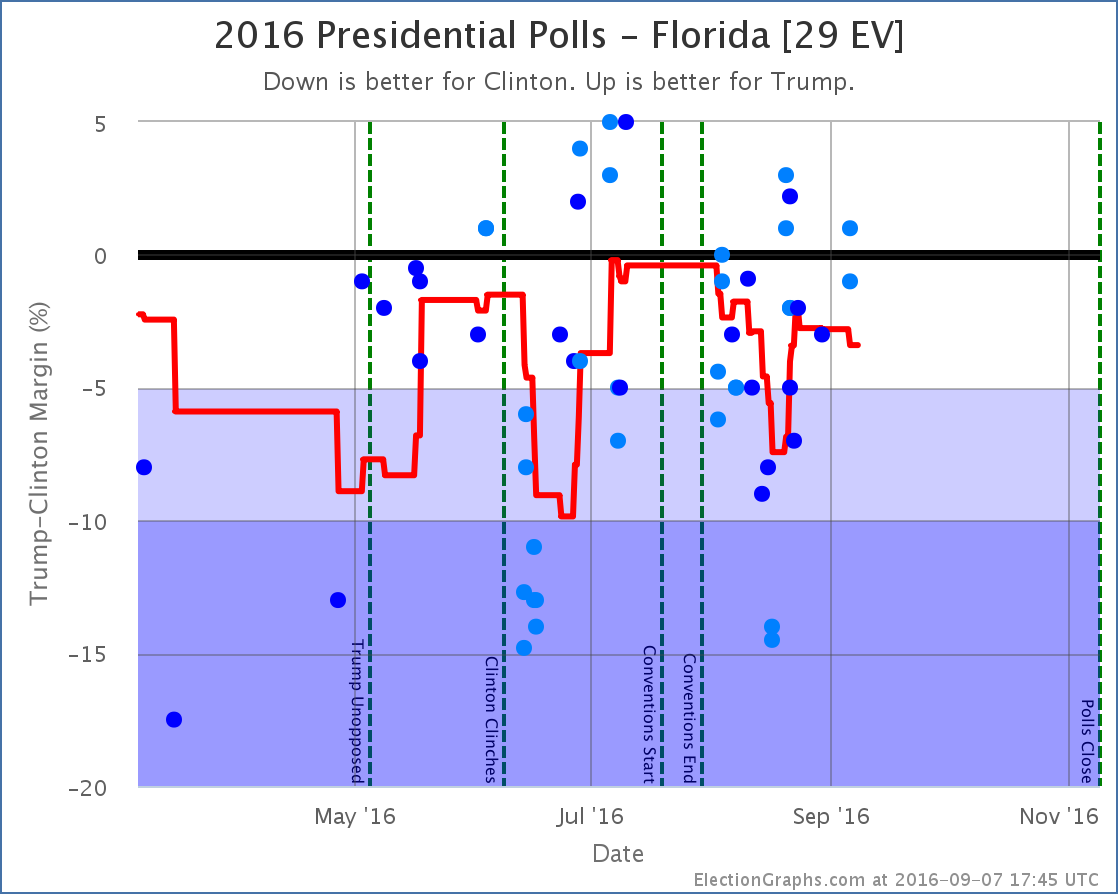
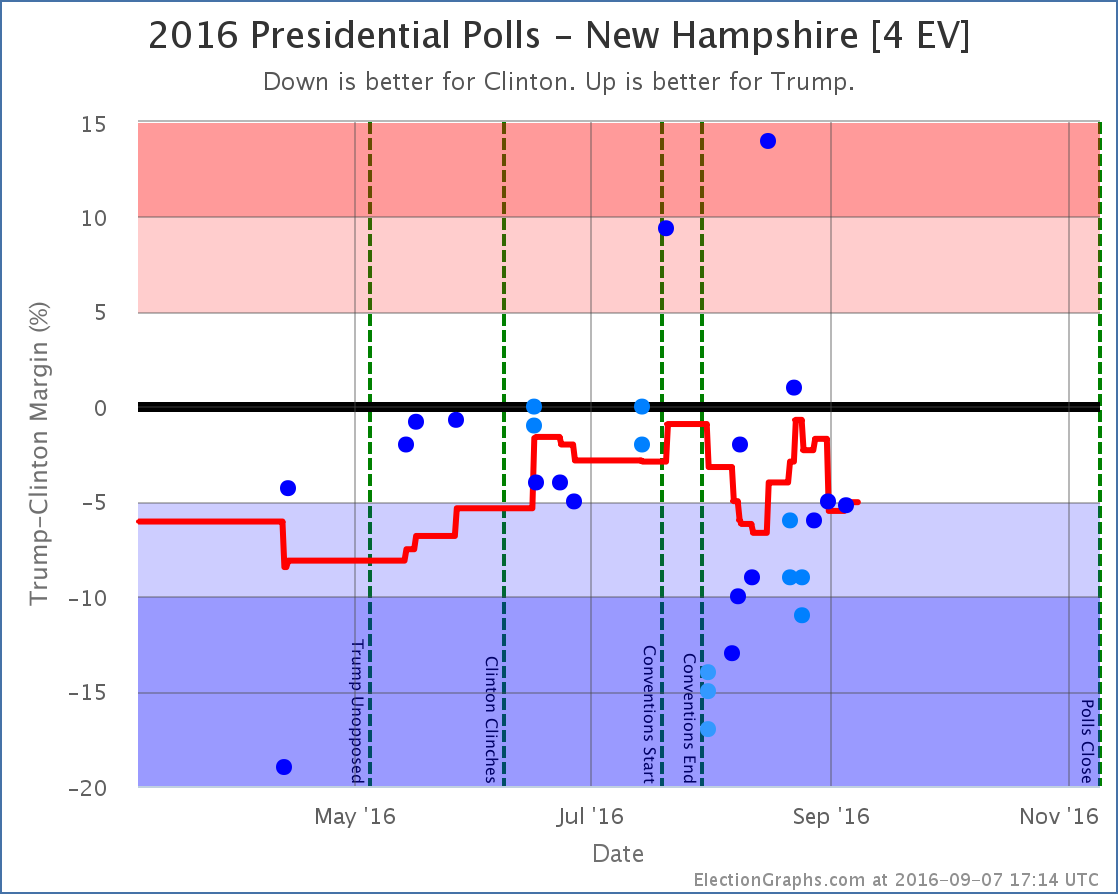
Both Florida and New Hampshire show the typical pattern of the Trump collapse followed by a Trump recovery. But in these two states, Trump peaked and is starting to drop again.
Florida does not change categories, but the change there changes the national tipping point.
In New Hampshire, the average just barely passes our 5% threshold to put the state back in the “Strong Clinton” category, which removes New Hampshire from Trump’s best case. It is right on the line though. Clinton’s lead still rounds to 5.0%. The next poll could easily move this back into “Weak Clinton”.
National View
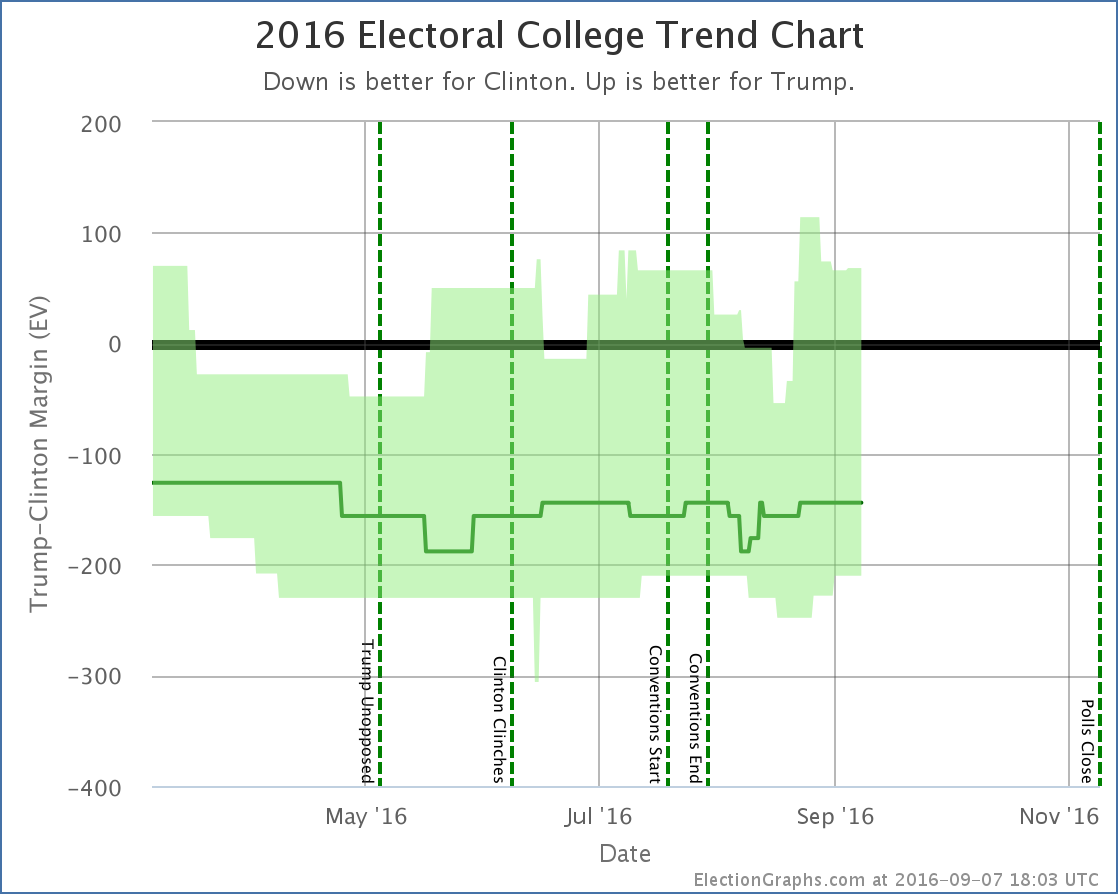
The change from today’s update to Trump’s best case is to move from winning by 56 electoral votes to winning by 66 electoral votes. So net improvement today.
But note the downward trend after August 27th. Even though today’s update was better for Trump, raising the level of the whole graph over the last week or so on the basis of some polls with older midpoints, it does look like his best case may have peaked and is receding a bit now.
Clinton’s best case is receding as well though. It drops in this update from winning by 248 electoral votes to only winning by 210 electoral votes.
And the center line has not shifted. We’re talking about changes in which states are close, not in who is leading where.
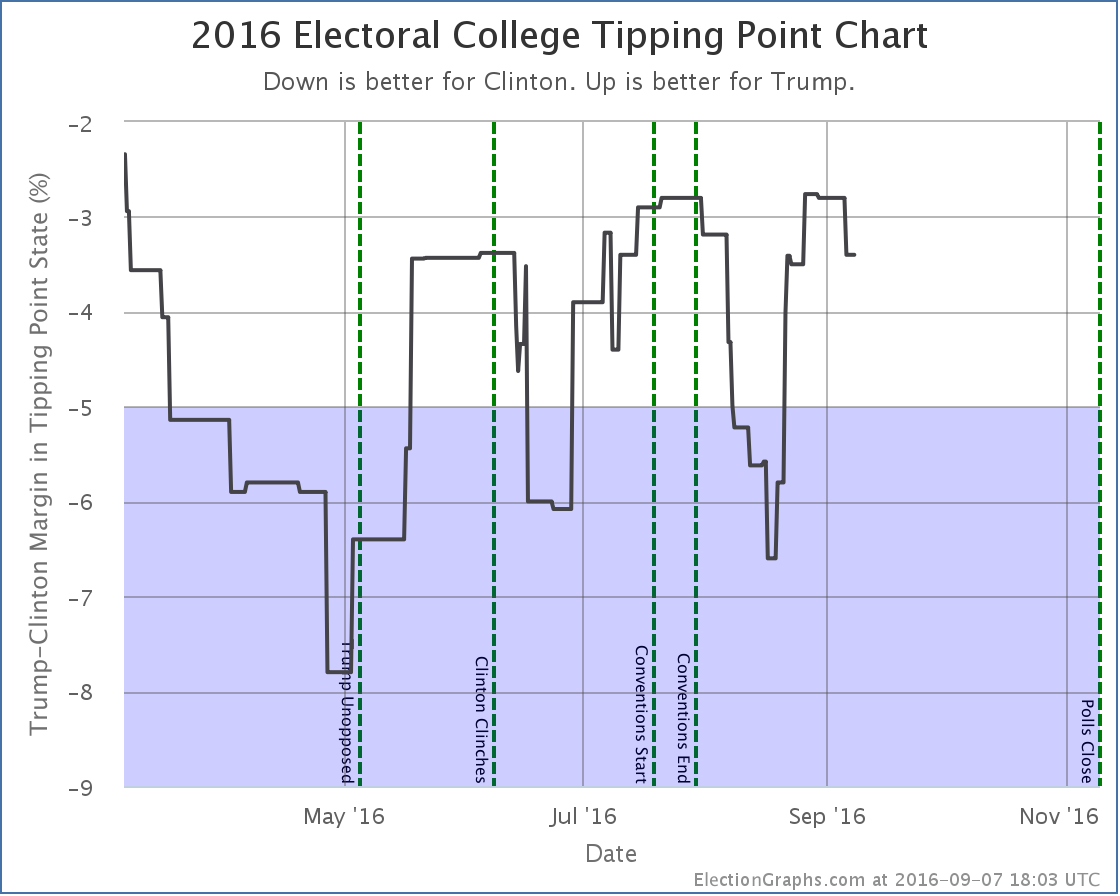
Today’s update moves the tipping point from Clinton by 3.0% in Florida to Clinton by 3.4% in Florida, but you can see that the tipping point peaked a little over a week ago and has been moving toward Clinton, similarly to how Trump’s best case has been moving.
So has Trump really already passed another peak? Is he on a downswing again? Or is this all just reversion to the mean on a race that really is pretty stable? Or does Clinton weakening in the red states she had hoped to pick up mean Trump still has some momentum left?
Stay tuned.
62.1 days until real election results start to come in.
Note: This post is an update based on the data on ElectionGraphs.com. Election Graphs tracks both a poll based estimate of the Electoral College and a numbers based look at the Delegate Races. All of the charts and graphs seen in this post are from that site. Additional graphs, charts and raw data can be found there. Follow @ElectionGraphs on Twitter or like Election Graphs on Facebook to see announcements of updates or to join the conversation. For those interested in individual general election poll updates, follow @ElecCollPolls on Twitter for all the polls as they are added. If you find the information in these posts interesting or useful, please consider visiting the tip jar.
States with new poll data since the last update: New Hampshire, Georgia, Florida, Indiana, Texas, Virginia, Washington, New York, Michigan, Missouri, Colorado, Iowa, Mississippi
The Trump deterioration continues. This time in the form of weakening in Missouri:
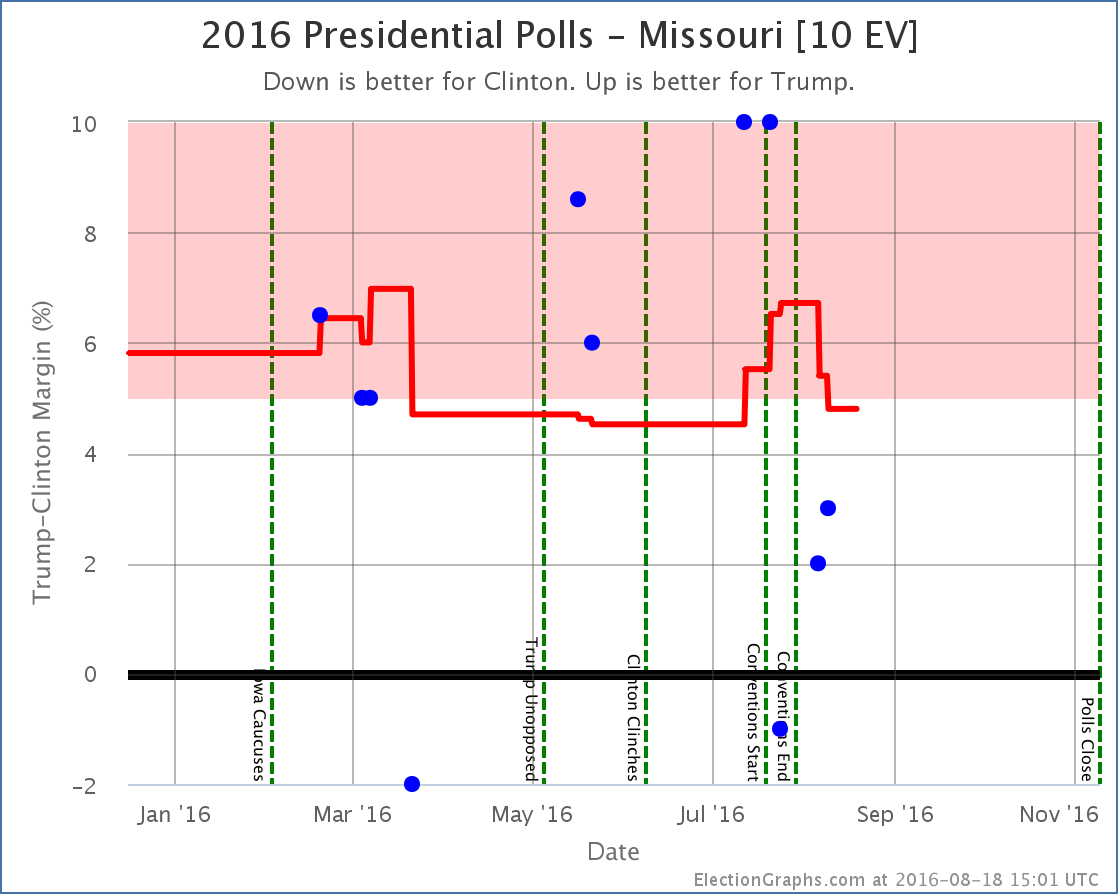
The range in Missouri results is large in the 1.2 months of polling currently used in the average… from Trump up by 10%, to Clinton up by 1%. But the last four polls before the end of the Republican convention all showed Trump up by more than 5%. The three polls taken after the Republican convention ended have all been worse for Trump.
So Trump’s lead in the poll average drops to 4.8%, and Missouri moves from “Strong Trump” to “Weak Trump”. Trump is still ahead, but it is now close enough that we allow the possibility of Clinton winning Missouri in her “best case”.
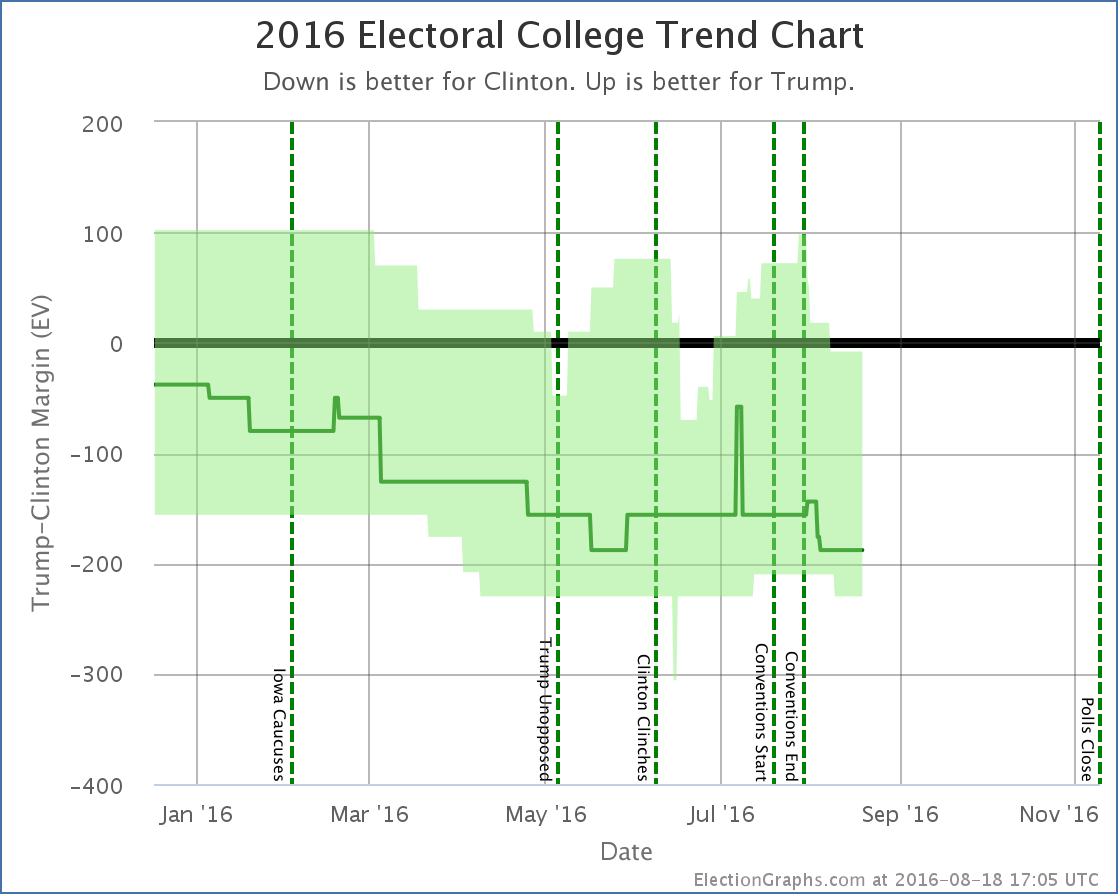
Clinton’s best case is now to win 384 to 154, a 230 electoral vote margin. This is the best number Clinton has seen on this metric aside from a two day period in June where Texas looked close for a moment.
Trump may stop sliding in the polls, or maybe even reverse the trend, but we’re not seeing that yet. For the moment, his collapse continues.
82.3 days until polls start to close on election day.
Note: This post is an update based on the data on ElectionGraphs.com. Election Graphs tracks both a poll based estimate of the Electoral College and a numbers based look at the Delegate Races. All of the charts and graphs seen in this post are from that site. Additional graphs, charts and raw data can be found there. Follow @ElectionGraphs on Twitter or like Election Graphs on Facebook to see announcements of updates or to join the conversation. For those interested in individual general election poll updates, follow @ElecCollPolls on Twitter for all the polls as they are added. If you find the information in these posts interesting or useful, please consider visiting the tip jar.
States with new poll data since the last update: New Hampshire, Alabama, Illinois, Alaska, Arkansas, Arizona, California, Colorado, Connecticut, DC, District of Columbia, Delaware, Florida, Georgia, Hawaii, Iowa, Idaho, Indiana, Kansas, Kentucky, Louisiana, Massachusetts, Maryland, Maine, Michigan, Minnesota, Missouri, Mississippi, Montana, North Carolina, North Dakota, Nebraska, New Jersey, New Mexico, Nevada, New York, Ohio, Oklahoma, Oregon, Pennsylvania, Rhode Island, South Carolina, South Dakota, Tennessee, Texas, Utah, Virginia, Vermont, Washington, Wisconsin, West Virginia, Wyoming.
In addition to a handful of new polls, this batch of updates includes two sets of 50 states plus DC data from Morning Consult, one released in April covering January through March (with multiple candidate pairs), and another released in July covering April through June (covering only Clinton vs Trump). These span really long time periods and use a slightly different methodology than other polls, so I had initially not included them. But I was convinced by @hominidviews that I actually should include them, so they are now folded into the data.
In most cases, since the middates of the polling periods are fairly far in the past at this point, the addition of these polls only jiggled the lines around in the past rather than changing the situation as of today. Even in the sparsely polled states where these polls did change the average, categories did not generally change.
The one exception for Clinton vs Trump was Missouri:
Missouri
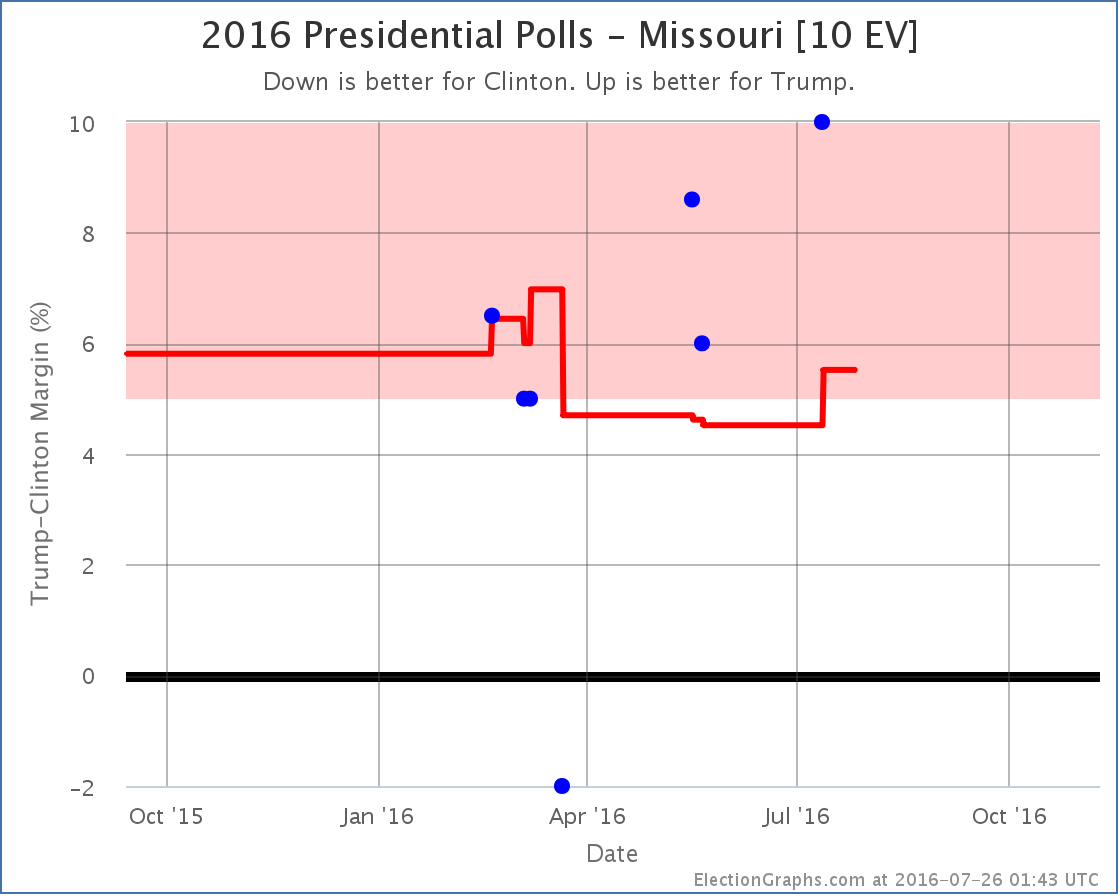
With the new Morning Consult poll centered in May added, the July PPP poll was enough to end Missouri’s time as a close state that was caused by a March DFM poll that now looks like a pretty clear outlier. So Missouri moves from “Weak Trump” to “Strong Trump” and it is therefore no longer listed as a possible pickup for Clinton.
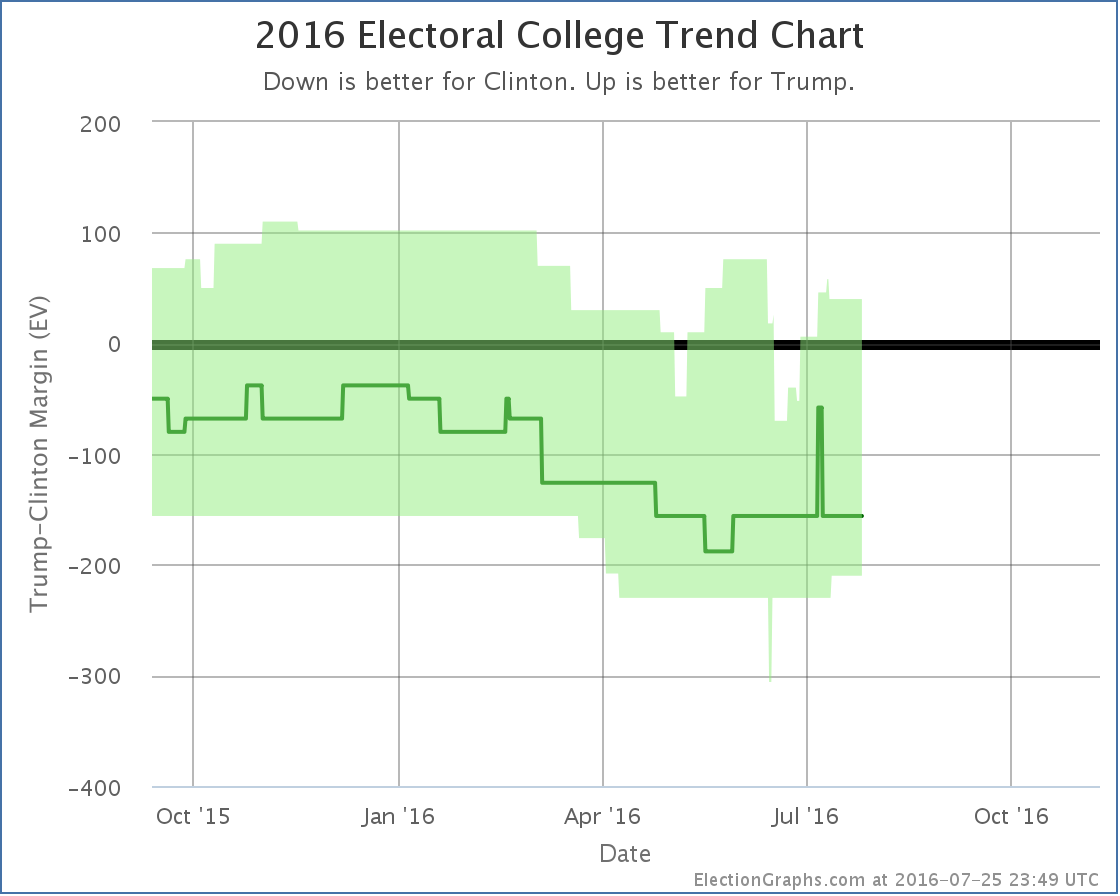
Back in the past, you can see a few new features added by the Morning Consult polls… a dip in the expected line for a little while in May where Clinton briefly was in the lead in Georgia, and a spike in Clinton’s best case where she got within 5% in Texas… for one day.
The only change that hasn’t already come and gone is the change in Missouri. Clinton’s best case goes from winning by 230 electoral votes down to winning by 210.
Note this is not part of any “convention bump”. This change is due to poll information from before the convention. There should be new polls added soon that will tell us more about the impact of the conventions. This is not that.
Clinton vs Cruz
Oh, and the Morning Consult data had some Clinton vs Cruz information as well. Since that combination is still one of the five best polled combinations, even though Cruz lost, I’ll note the changes: Kentucky went from Strong Cruz to Weak Cruz, and Minnesota went from Strong Clinton to Weak Clinton. So Clinton’s best case moved from winning by 188 to winning by 204, and Cruz’s best case went from winning by 30 to winning by 50.
Note: This post is an update based on the data on ElectionGraphs.com. Election Graphs tracks both a poll based estimate of the Electoral College and a numbers based look at the Delegate Races. All of the charts and graphs seen in this post are from that site. Additional graphs, charts and raw data can be found there. Follow @ElectionGraphs on Twitter or like Election Graphs on Facebook to see announcements of updates or to join the conversation. For those interested in individual general election poll updates, follow @ElecCollPolls on Twitter for all the polls as they are added. If you find the information in these posts interesting or useful, please consider visiting the tip jar.
Since the last update there have been polls added in Wisconsin, New York, and Missouri. Missouri makes a difference in our models for Clinton vs Trump.
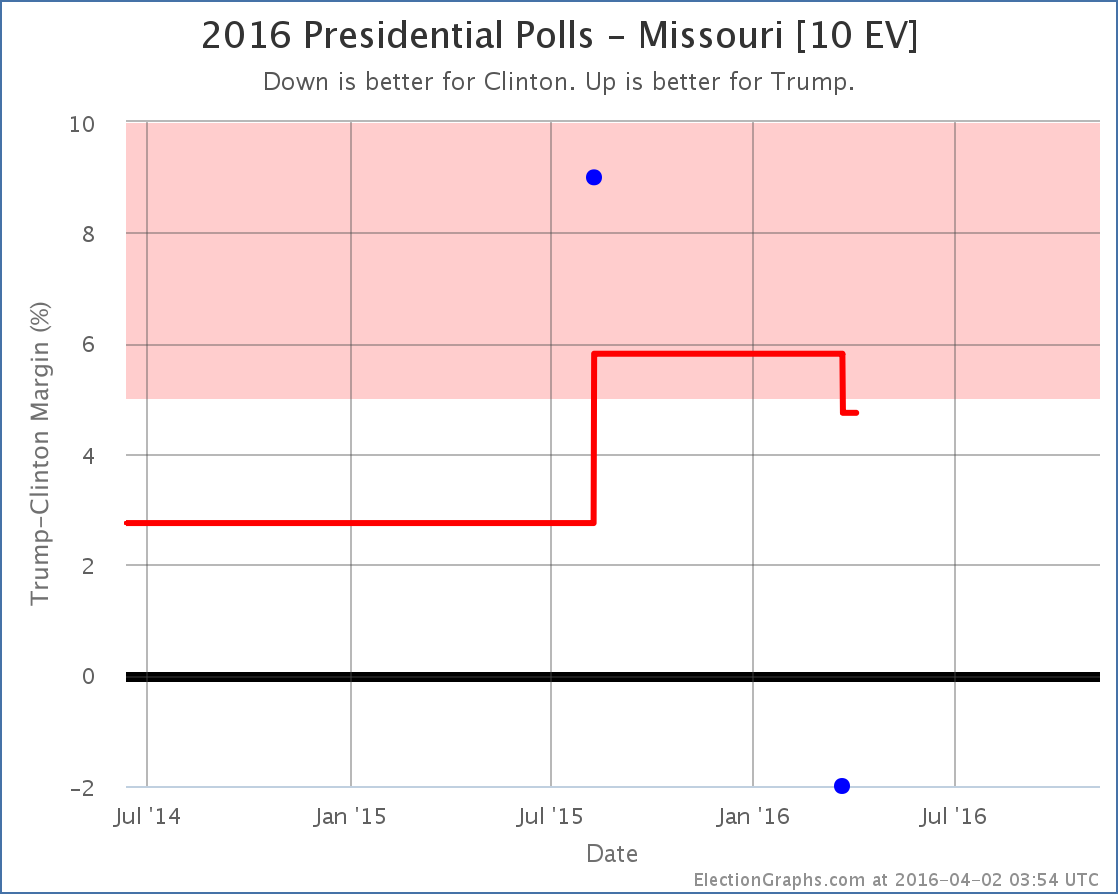
Missouri has been very lightly polled. This is only the second poll that specifically asks about Clinton vs Trump, so my five poll average is still filled out with the election results from 2004 to 2012. Without those old elections, the average would move even further in Clinton’s direction. The newest poll actually shows Clinton ahead, but it is just one poll. Never trust one poll. We look at averages. As it is, the average now stands at Trump +4.7%.
This now puts Missouri back in the “close enough it could go either way” category.
This improves Clinton’s best case against Trump:
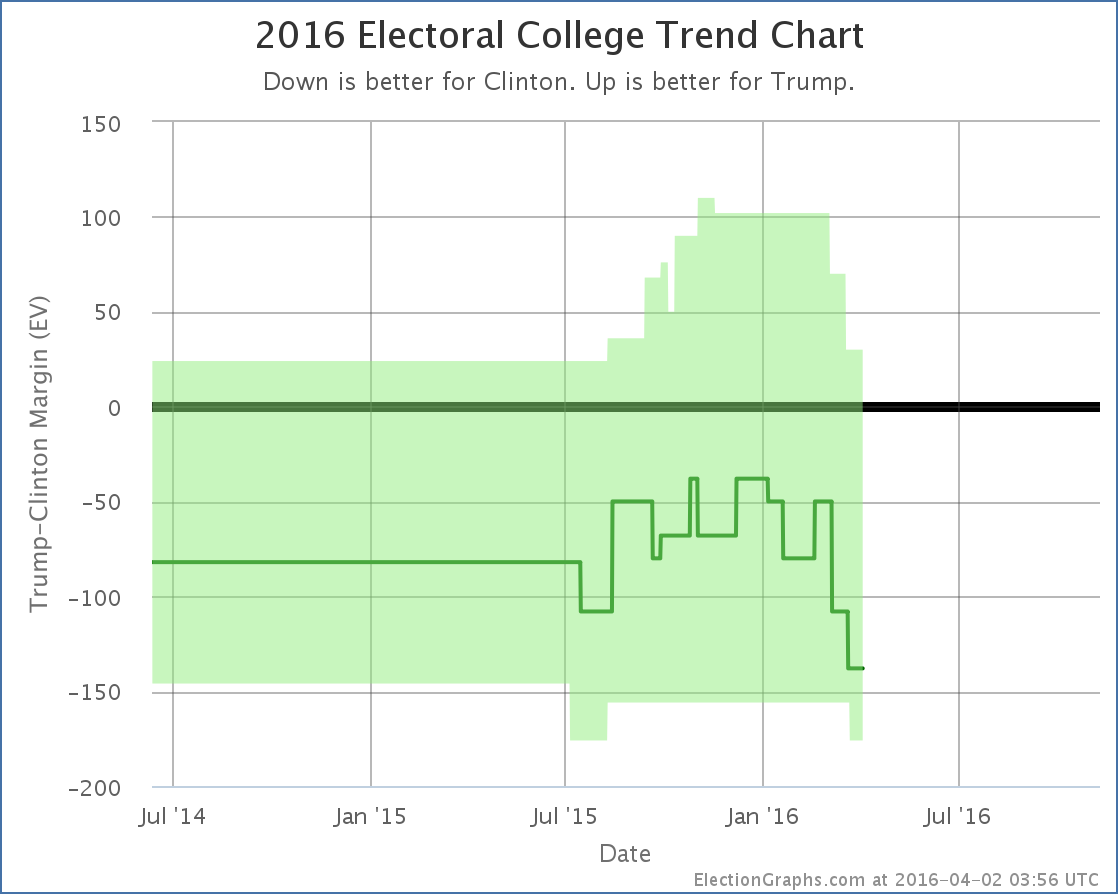
Clinton’s best case if she wins all the states she is ahead in, plus the two where she is close (Colorado and now Missouri) is to win 357 to 181, an 176 electoral vote margin.
Looking at the chart above, since the new year there have been eight changes (5 to the expected case, 2 to Trump’s best case, and 1 to Clinton’s best case). Seven of those changes have favored Clinton. Only one has been a move toward Trump.
Trump’s situation has deteriorated significantly in the last three months. The question is of course if he is near a bottom and about to rebound, or if he has only started his fall and soon the real discussion will not be who would win, but rather how big a win Clinton would have.
Of course, all of that is only relevant if he ends up as the nominee. The delegate race is still underway and Trump has a very narrow path to follow to get to the convention with a majority of delegates. If he falls short, we get a contested convention, and it looking less likely by the day that Trump walks out of that scenario with the nomination. (See nice 538 writeup on this here.)
220.0 days left until polls start to close on election night 2016. There will be lots of ups and downs between now and then. Stay tuned!
Note: This post is an update based on the data on ElectionGraphs.com. Election Graphs tracks both a poll based estimate of the Electoral College and a numbers based look at the Delegate Races. All of the charts and graphs seen in this post are from that site. Additional graphs, charts and raw data can be found there. All charts above are clickable to go to the current version of the detail page the chart is from, which may contain more up to date information than the snapshots on this page, which were current as of the time of this post. Follow @ElectionGraphs on Twitter or like Election Graphs on Facebook to see announcements of updates or to join the conversation. For those interested in individual general election poll updates, follow @ElecCollPolls on Twitter for all the polls as they are added.
Two sets of changes worth noting today triggered by new PPP polls in Iowa and Missouri. The streak of changes going against Clinton and in favor of the various Republicans continues. As I mentioned before, the last time one of my updates was unequivocally good news for Clinton was in May!
Iowa
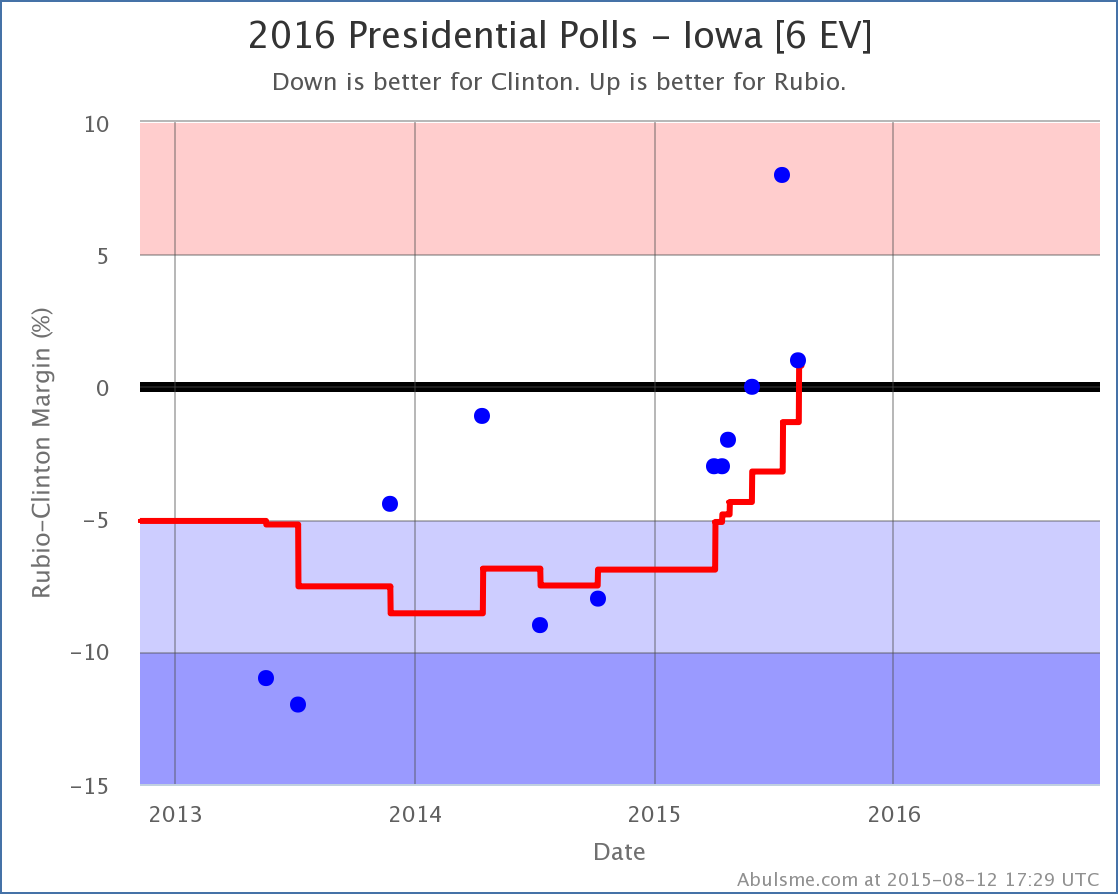
The July Qunnipiac Poll showing Rubio with an 8% is looking kind of like an outlier, and without it we wouldn’t be quite there yet, but there has been a clear trend toward Rubio in the average going back a year. With the newest poll (plus that possible outlier) the average moves from “Weak Clinton” to “Weak Rubio”. This changes the “expected” result in this matchup:
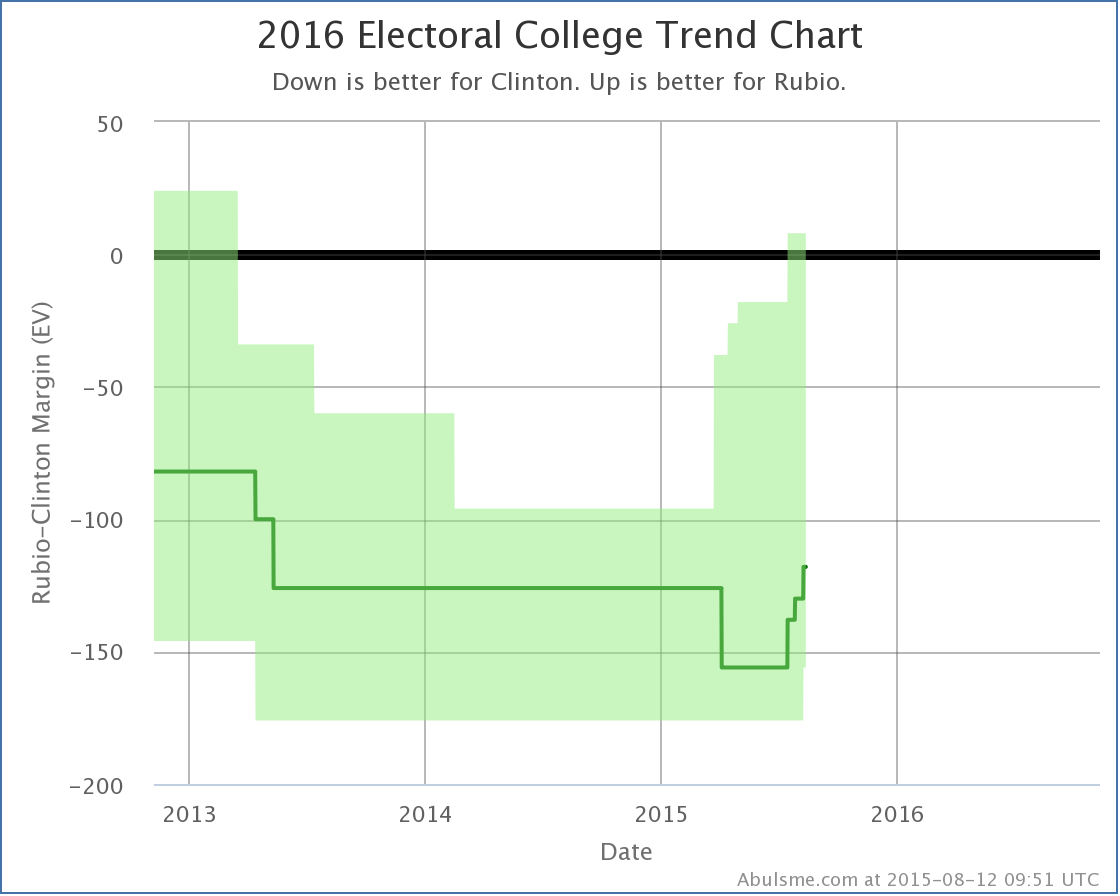
The expected result is now Clinton 328 to Rubio 210, which is a 118 electoral point loss by Rubio. Now, while this is still of course a significant loss, it is significant because it beats Romney’s 126 electoral vote loss against Obama in 2012. The last time one of the five best polled candidate combinations had the Republican outperforming Romney was back in June when Bush had pulled his expected loss down to only 98 electoral votes.
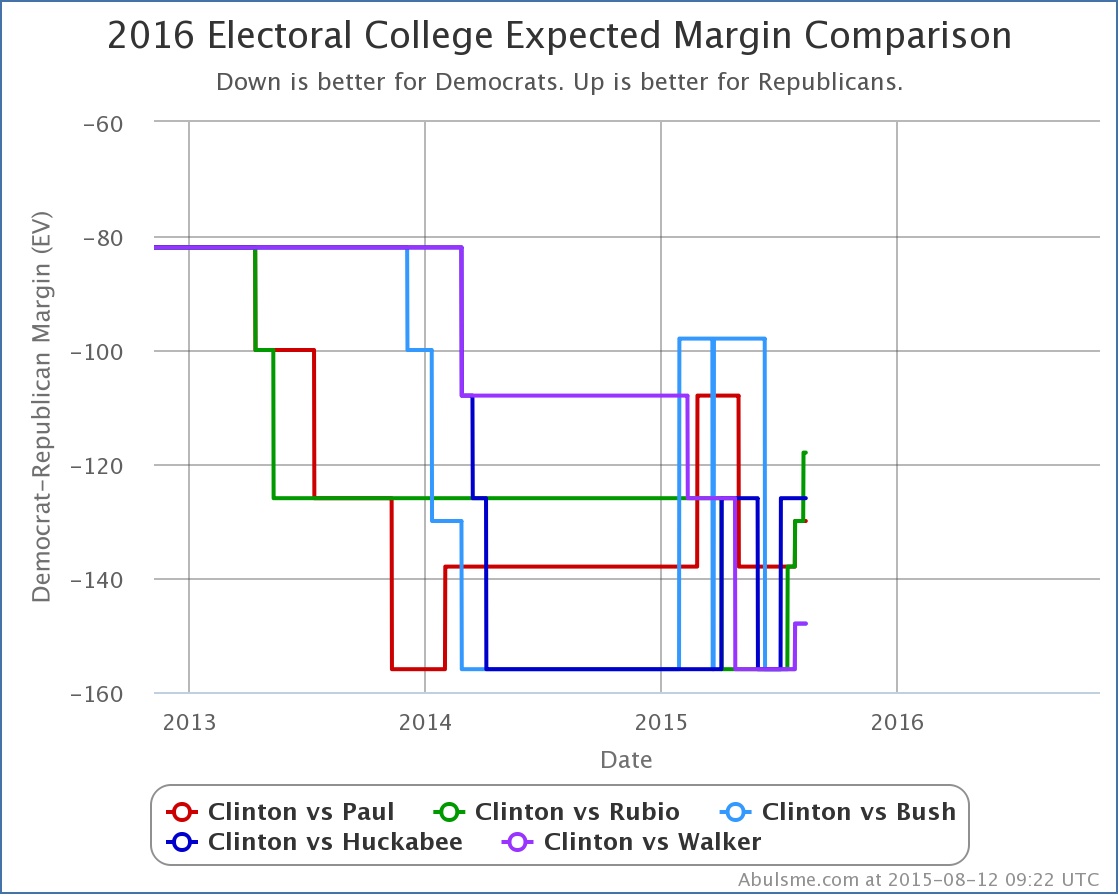
While there has been a general drumbeat of bad news for Clinton in my updates for the last three months, this particular chart doesn’t yet show an clear and indisputable breakout move beyond the range where these candidates have been bouncing around. If you only look at the changes since June, it starts to look like a trend though, and given the movement in other metrics, it is still reasonable to interpret this as a bad trend for Clinton.
The question though will be if the Republicans can start an actual breakout move where instead of talking about how it looks like they might beat Romney, we start talking about how it looks like they might beat Clinton. We aren’t close to that yet.
One thing people have been speculating about has been if the prominence of Trump on the Republican side right now is actually harming the party overall, specifically in terms of the ability of the other candidates to compete against Clinton. So far, there is no evidence for that at all in the numbers we track here.
Missouri
When I officially launched the election tracking site and posted my first analysis for 2016 I mentioned that if you looked at the average results for the last five general elections… the data I used to “seed” the analysis before there were actual state polls… there were only SIX states where the average margin in these five elections was less than 5%. They were Nevada (Dem+2.8%), Ohio (Dem+1.7%), Florida (Dem+0.9%), Colorado (Rep+0.0%), Virginia (Rep+1.6%) and Missouri (Rep+2.8%). All of these states were polled long ago, some many times… except Missouri. Today’s PPP poll is the first 2016 polling for Missouri that I am aware of. So finally, we get a current view of the state.
Missouri was basically on this “Close State” list because Bill Clinton won the state by 6.3% in 1996, the oldest of the five elections I used for the initial average. Since then the Republicans won by 3.3%, 7.2%, 0.1%, and 9.4%. OK, that 0.1% in 2008 was really close. And the 3.3% in 2000 wasn’t a complete blow out. But in general it seems like the trend has been redder in Missouri.
The new poll tested Clinton against 11 different Republicans. She lost by between 7% and 15% depending on which Republican you looked at. (They also tested Sanders against 4 Republicans with similar results.)
Bottom line, looks like 2016 is looking a lot more like 2012 or 2004 than 2008 or 2000. That is, a pretty strongly Republican state. Now, it is just one poll, but the results are strong enough that the state immediately moved from “Weak Republican” to “Strong Republican” for all five of the best polled candidate combinations. (And actually for all the rest of the combinations they polled too.)
The chart of this isn’t actually all that interesting on a state level. But Missouri no longer being a close state means that Clinton’s “best case” against all five Republicans weakens a little bit, so lets have a quick look at that graph:
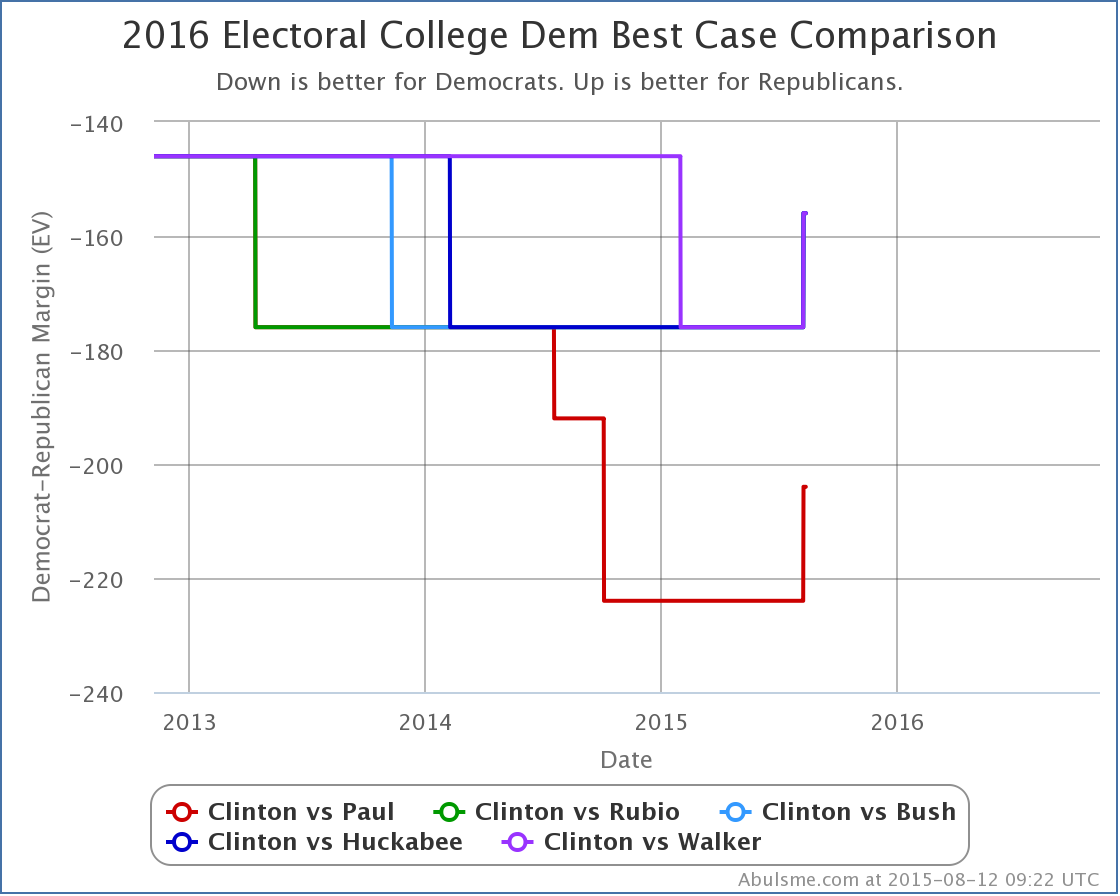
You don’t see a lot of volatility in this chart, simply because there are a lot fewer polls of the states that make a difference here. You see a lot of polls around the tipping point, and around the states that are really close, because they give insight into if the Republicans are catching up. Given the current state of Clinton’s lead, polling of the states Republicans are generally already ahead in only gives insight into how much extra Clinton could win by if everything possible went her way, which is fundamentally less interesting.
Never the less, with Missouri’s 10 electoral votes out of play at the moment, Clinton’s best case margin drops by 20 electoral votes against all these candidates. In the case where she wins all the states she is ahead in, plus all the states where the Republican currently leads by less than 5%, she now beats Paul by 204 electoral votes. Rubio, Bush, Huckabee and Walker get beaten by a more modest 156 electoral votes. These are of course pretty good margins in today’s polarized electorate. But to get to these kinds of numbers, just about everything would have to go Clinton’s way… which is not the trend today.
But of course, we have 454.2 days until the election. Lots can change in 454.2 days. :-)
Best Polled List
I should also mention that the “best polled” list got shuffled a bit with the latest updates. Clinton vs Paul once again grabs the “best polled” spot and becomes the default view on election2016.abulsme.com. Meanwhile Clinton vs Christie drops to 6th place and out of the group we highlight here, replaced by Clinton vs Huckabee returning to the top five after a short absence. Clinton vs Huckabee is just barely out of the top 5, but any other candidate combinations are far behind in terms of the volume and breadth of available polling on the state level at the moment. We’re currently giving the most attention here to Clinton vs Paul, Rubio, Bush, Huckabee and Walker.
Note: This post is an update based on the data on my 2016 Electoral College Analysis Site. All of the charts and graphs seen here are from that site. Graphs, charts and raw data can be found there for the race nationally and in each state for every candidate combination that has been polled at the state level. In addition, comparisons of the best polled candidate combinations both nationally and each in each state are available. All charts above are clickable to go to the current version of the detail page the chart is from, which may contain more up to date information than the snapshots on this page, which were current as of the time of this post. Follow @ElecCollPolls on Twitter for specific poll details as I add them.
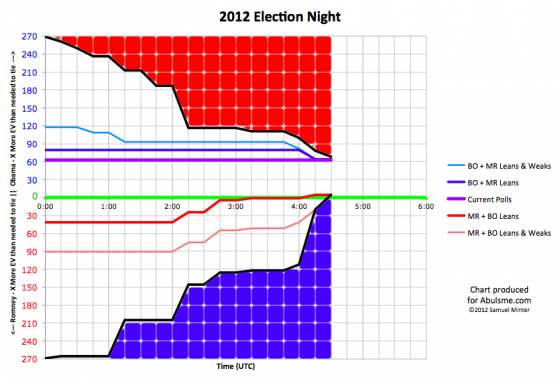
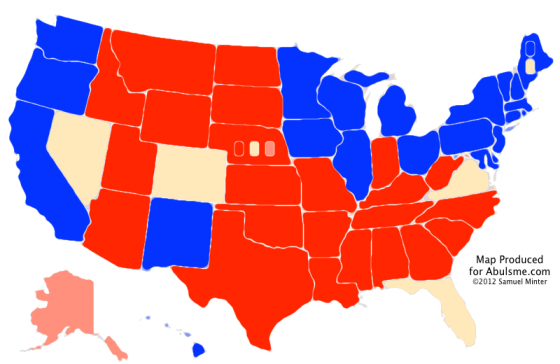
|
Romney |
Obama |
| Romney Best Case |
264 |
274 |
| Current Status |
206 |
332 |
| Obama Best Case |
205 |
333 |
Between 04:15 and 04:30 UTC, three more states were called. Missouri for Romney, and Oregon and Ohio for Obama. All three of these were fully expected, but Ohio put Obama over 270.
CNN waited until they called Ohio at 04:18 UTC to call the election, even though based on the polls by the time we got to election day, Ohio wasn’t even close. Once Iowa was called 9 minutes earlier, Romney had no more ways to win.
At this point, the only question is the margin of Obama’s victory.
As of this update, the five poll average hasn’t missed a state yet. Four states and two congressional districts to go.
(Of the close ones… there is also Alaska and Nebraska’s 3rd, but those will certainly go to Romney.)
Edit 2012 Nov 7 05:13 to add that last parenthetical note.
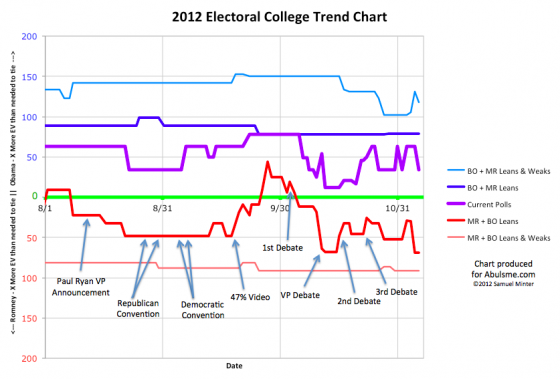
Today was by far the biggest update I’ve ever done. New polls in 31 states plus the Maine congressional districts. Absolutely exhausting checking all my sources and entering in all the data today. After all that though, the result is three states changing status, with none of those status changes making a big difference in the race. Time for a quick look before we get to the meatier stuff:
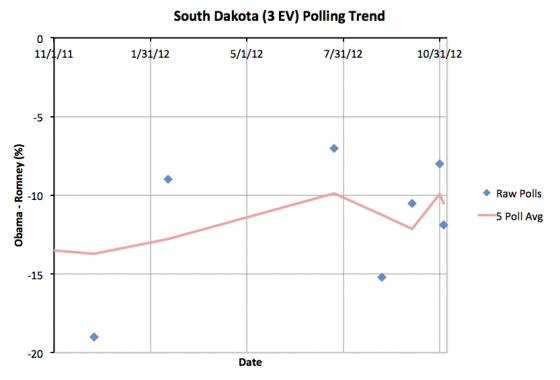
On Saturday Romney’s lead in the South Dakota five poll average dropped below 10%. With today’s update is is once again slightly more than 10%. Romney’s going to win South Dakota. (Graph shows a year since polling has been so sparse here.)
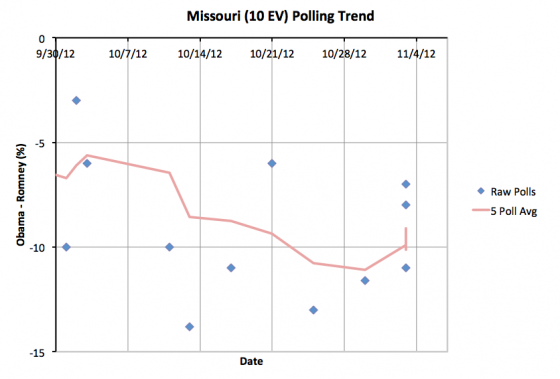
Some story in Missouri. Just yesterday Romney’s lead in the five poll average dipped below 10%. Today it is above 10% again. Romney will win Missouri.
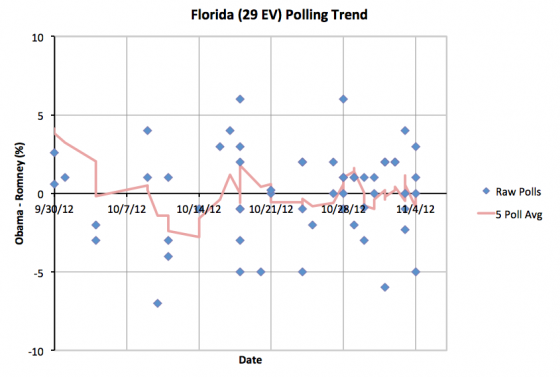
Finally Florida. While the other two don’t really matter much to the state of the race because Romney is clearly going to win both, Florida isn’t all that significant right now because the fact that Florida has once again bounced across the line, and now has Romney narrowly ahead, does not actually give any additional insight into the state of the race in Florida. Florida has been bouncing back and forth close to the line. Small fluctuations up and down are just sampling noise. The best we can say about Florida is that it is tied, and there is no indication that the state is breaking one way or another. As I’ve said several times before, we’ll know which way Florida goes once all the votes are counted. We may not even know on election night depending how it goes.
So, the current state of the race with just about a day to go before the polls start closing:
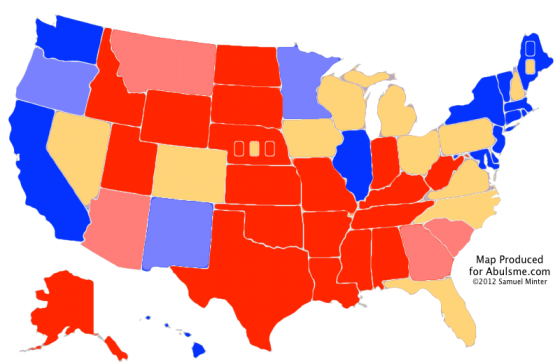
|
Romney |
Obama |
| Romney Best Case |
338 |
200 |
| Current Status |
235 |
303 |
| Obama Best Case |
190 |
348 |
So goodbye to 332-206 for the moment, and perhaps for good. There isn’t that much time left after all.
Fundamentally, we have no significant change to the race today in terms of the three main lines in my summary. Obama is still heavily favored, but Romney can still win if he manages to defy expectation and win in a bunch of the close states.
So, here we go again, looking at those close states.
With just the states he is ahead in by more than 5%, Romney starts at 190 electoral votes. Then if we go in order…
- Nebraska 2nd (1): Romney ahead by 3.8%
- North Carolina (15): Romney ahead by 1.4%
- Florida (29): Romney ahead by 0.4%
That is all the states (and CDs) Romney is actually ahead in based on my five poll average. That gets him to 235 electoral votes. 34 electoral votes short. If you continue to bring the states in order of Romney’s support level…
- Colorado (9): Obama ahead by 1.2%
- Virginia (13): Obama ahead by 1.6%
- Iowa (6): Obama ahead by 2.0%
- New Hampshire (4): Obama ahead by 2.8%
- Maine 2nd (1): Obama ahead by 2.8%
- Ohio (18): Obama ahead by 3.1%
Ohio is once again the tipping state. If Romney pulled all of these in, he would have 286 electoral votes and therefore win the presidency. Now, if Romney does indeed win Ohio, he could then afford to actually lose Iowa, New Hampshire and Maine’s 2nd.
This leaves Romney’s current “easiest path to victory” to be holding on to the three states he is ahead in, and then pulling ahead and winning in Colorado, Virginia and Ohio.
There are other paths involving the remaining close states, which are:
- Pennsylvania (20): Obama ahead by 4.2%
- Wisconsin (10): Obama ahead by 4.3%
- Michigan (16): Obama ahead by 4.5%
- Nevada (6): Obama ahead by 4.8%
There are certainly ways some of those states could be part of a path to 270 (or 269) for Romney, but since Obama is even further ahead in those states, that kind of movement seems even more unlikely.
So looking at the tipping point margin graph:
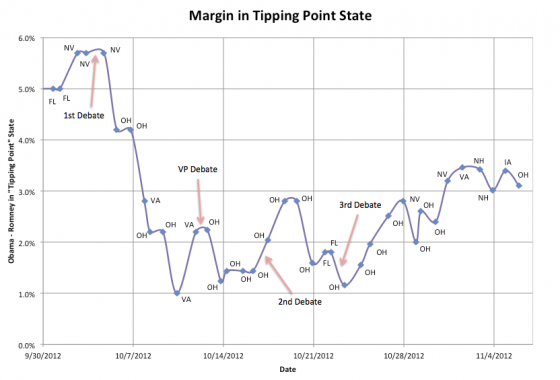
The race has been stable for the last week.
Romney is out of time. If there was going to be a last minute move toward Romney in the swing states, it needed to have been happening over the last few days. There is nothing. States appear to be jiggling around a bit due to the sheer volume of polling that is happening right now, but there is no real indication of any movement that makes any sort of difference to this race.
The best bet for the Romney team remains that all the polls are just systematically wrong, and the reality is that a lot of the states I listed above are actually at least 3% better for Romney than they look from the polling. There HAVE been presidential election years where the state polls were off by that much. So this is not impossible….
…just pretty unlikely.
Absent a miracle for the Romney folks, this looks like Obama getting reelected.
Before I close for the day, just a quick note.
The plans for abulsme.com for the next 48 hours had been one final update to these polling charts before the polls start to close less than 24 hours from now. After that I was planning to do what I did in 2008, which was updates to the website every 15 minutes or so as states get called one way or the other by the major networks. The networks usually only call the election itself when one candidate actually gets to 270 electoral votes, but really, you will probably know well in advance of that, as one can already assume how many states will go. You do not have to wait for the polls to close in California to know that Obama will win California for instance.
The plan above may still happen, but life may get in the way. I just got word within the last two hours that my mother-in-law is getting released to go home after having had major surgery a couple of weeks ago… which is great, because it means she is doing well, but my wife needs to be there when she gets discharged, and to help her during the first week or two home. So my wife may need to be flying out of here, possibly as soon as tomorrow. Is she does, depending on exact schedules, I may not be able to do “election night coverage” after all as I’ll be needing to deal with things at home. If so, I might post the occasional comment on twitter, but won’t be furiously updating graphs all night long.
I should know better about what my plans will be by the time I post my final update tomorrow. Thanks for you patience!
Note: Chart and map from the Abulsme.com 2012 Electoral College Prediction page. Both assume Obama vs Romney with no strong third party candidate and show polling as it currently exists. Things will change before election day. On the map red is Romney, blue is Obama, gold states are too close to call. Lines on the chart represent how many more electoral votes a candidate would have
|
|































































